My Personal Information System
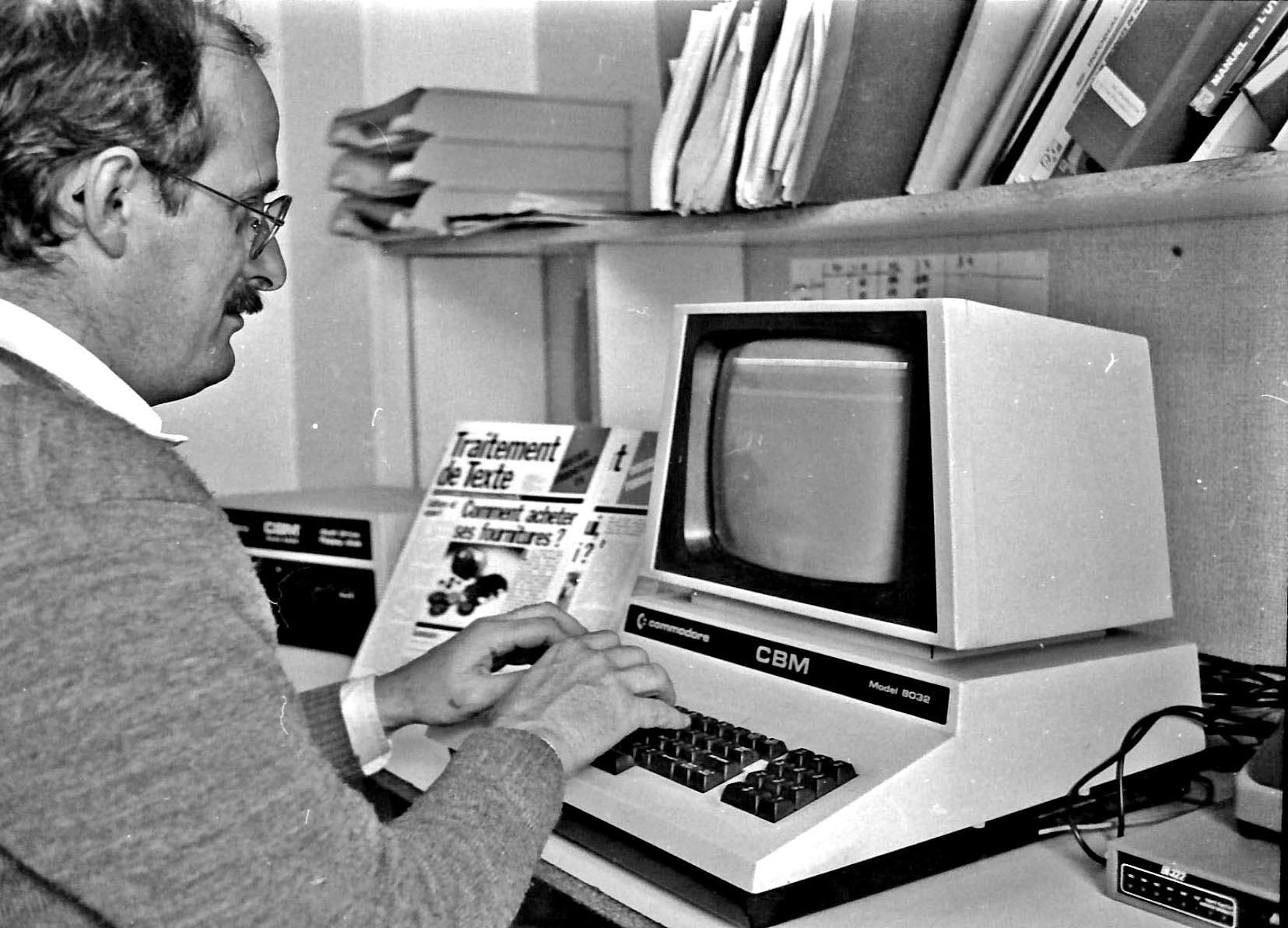 . 1982. My first computer with all possible applications... but only 16Kb of central memory and 1Mb of data on a double 8" floppy disk readar This same year, I had my first email exchanges on Internet through the minitel. Main applications: text writing, editorial cooperation. Some administrative tasks. Some games also on a smaller computer.
. 1982. My first computer with all possible applications... but only 16Kb of central memory and 1Mb of data on a double 8" floppy disk readar This same year, I had my first email exchanges on Internet through the minitel. Main applications: text writing, editorial cooperation. Some administrative tasks. Some games also on a smaller computer.
The pictures below are small to make browsing easy. They can be enlarged by clicking on them.
To developed, completed and edited. Last revion Nov. 20, 2014.
These notes draw a sketch of the roots and developments my personal information system, from its family origins to nowadays reality and projects. Since<s ideas and projects come before their implementation and explain it, we put a link on papers we wrote at different times.
All along these some 70 years, the aims have always been the same, with progressive widening and deepening:
- exhaustivity,
- integration, no redundancy (other than backups). Text, images, video.
- material accessibility with
network and mobiles, and copies for family members or friends.
- conceptual accessibility through hypertext and CMS. See Index of my workss.
- peenniality (copies, webserver).
All along these some 70 years, the applications of my computers as well as non digital tools have been centered on information, mainly professional, but also personal and for family. And marginally for games, entertainment (games) or art (with the exceptio of Roxame, to which Idedicated some 5 years at half time). There is a permanent growth of the assets: from some kilobytes (paper cards) in the 1940's to 90 gigabytes in 2014.
Until 1982, I create, distribute and store information mostly on paper, with some mechanical (typewriter) or optical/chemical (photography) tools. Any increase in information stored has its corresponding increase in paper volumes.
After 1982, a stronger and stronger proportion of new information is created through the keyboard. I begin to re-type ancient documents into the computer, but generally keep the original for safety and for pictures. Then the paper keeps growing, since electronic storage is scarce. .
After1998, the paper volumes begin to shrink, due to the scanner, and in particular the massive scanning of my paper files on computer users.
In 2002, the digital camera.replaces the chemicals. Later, progressively on some 5 years, all chemical documents (photo negative and movies) are digitized and discarded. The paper volumes are shrinking and my aim is to limit paper to the most beautiful or exemplary specimens.
Notes about some tools and media
- Books. My parents had not an important library at home. Let's say something like 200 titles, with a good proportion of childrens books.
Since my return from military service, books have constantly eaten a non neglihinlr budget.
When I became a journalist, I had a much more input flow of computer boods, offered as press service.
Then came the time, towards 1966, where books were becoming too bulky and I began to throw some of them in the garbage can, and later to sell them at brocantes. In 2005, I decided that the volume would remain constant, and that every new acquired book would be compensated by a sale, gift or throw.
- Paper documents in general.. The dynamics of paper as information support is for me a three phases process:
-
In the first phase, I receive, sort, select and archive paper documents
- In the second, I make indexes to have better access to these archives (for books and other documents)
- In the third, I scan (or type in the computer) the paper and keep only those for which "matter matters", such as beautiful books, personally dedicated or marked documents, personal letters of parents or friends.
For instance, since circa 1976, I have stored documents such as press articles, in arrival order, with a registration in a index table to find them at will and from different standpoints. A the end of 2014, I am reaching 7500 items. I have discarded a large part of them. But even for those, I cand trace them back and, possibly, get a new copy if they are public printed matter, for example.
For my diaries, I have them day after day, since Monday February 2, 1964 for the planning pages, and earlier for private notes. During some years, for privacy issues (notably during my military service) I used codes for persons names. But now I have some difficulties to decode these parts.
- Chemical documents (plates and films). They follow the same phases. For instance, I received circa 1977 a full case of photographic plates. I have scanned all of them. But until now not discarded them, looking for some possibly interested institution.
The main steps along 80 years
1930's (My parents)
Mother as well as Father, had a systemic orientation. They made card files, prescribed standard paper formats ("Commercial" format, 21x27 cem for instance, which was later replaced by A3).. *
My father was a publisher. Then, early in my life, I got contact with the printing technologies, which made a strong impression on me, from rather simple ones (a paper guillotine) to rather complex (offset printing machines with automated paper sheets feeding; as my Father at this time kept his notebooks, I found back the date of this visit, 11/2/1944).
As a civil servant during WW2, my father had to use punched cards. I saw one machine (a portable puncher) some day around 1943), and had quite forgotten it when I read (in 1972), the Carmille's book about Puchend cards (1938).
My father makes films, has a photo lab (BW. Tries color but stops). Rolleiflex. Hasselblad.
Cinema cams.First 9,5 mm, then 16 mm.
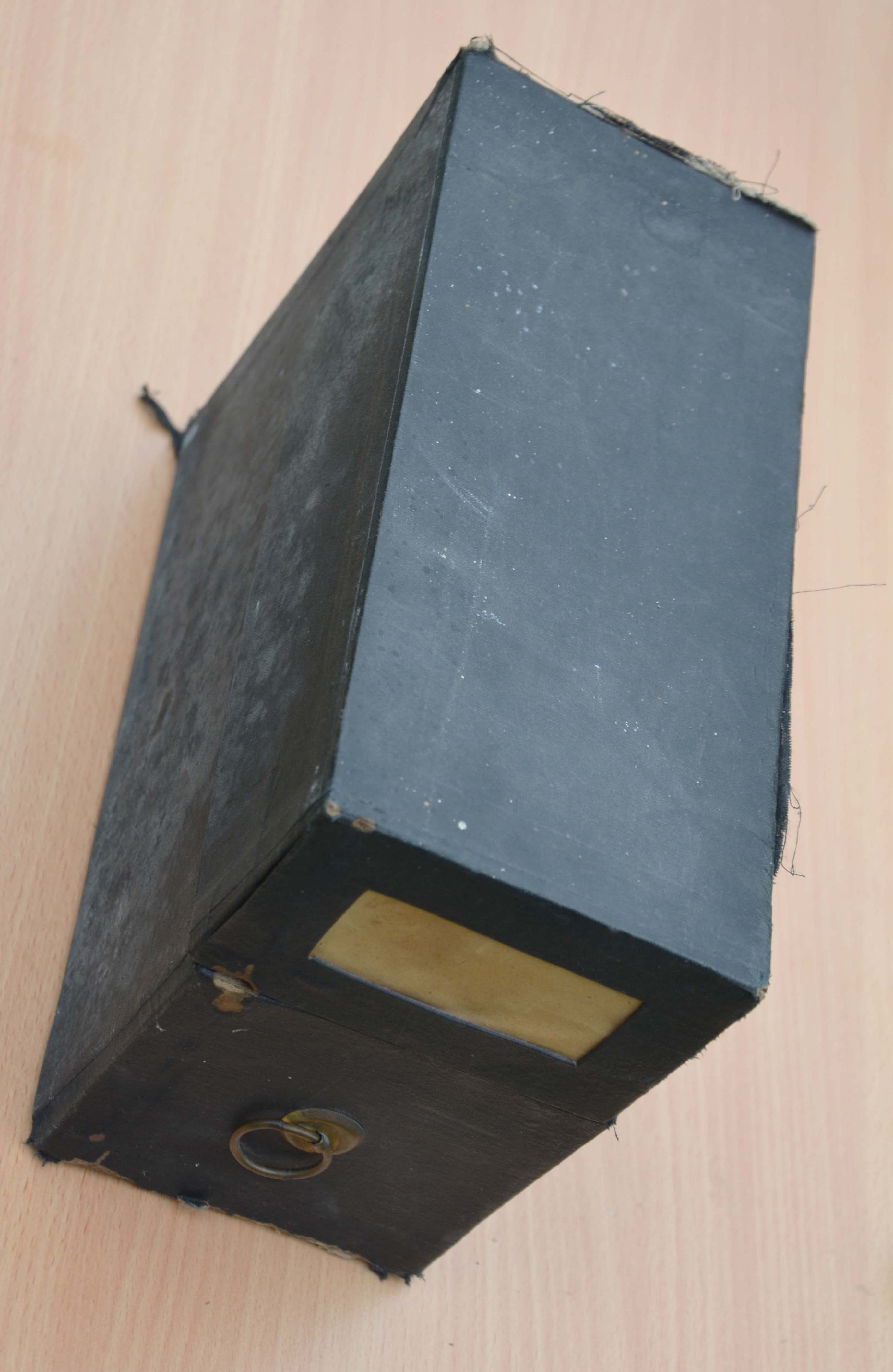
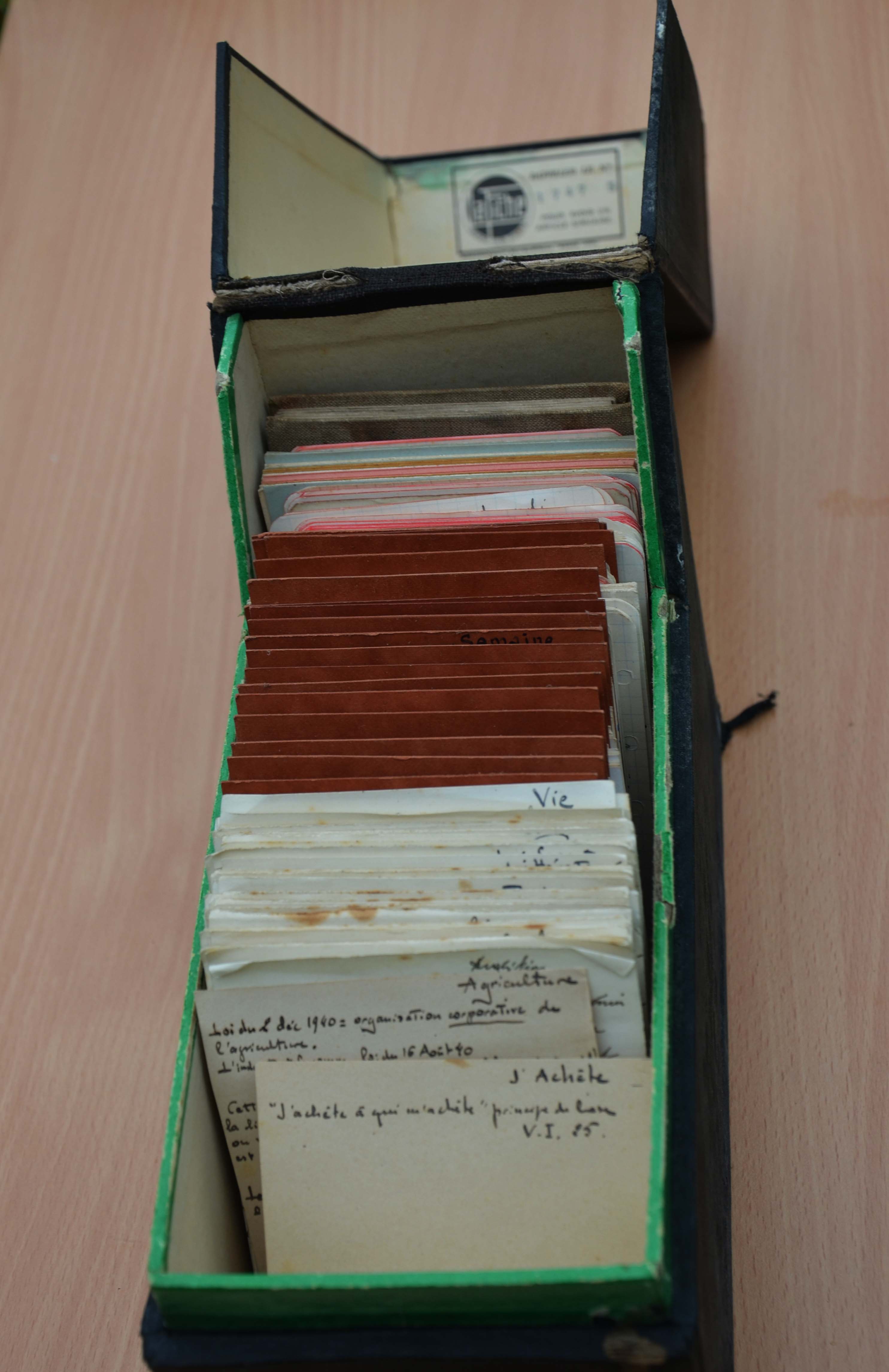
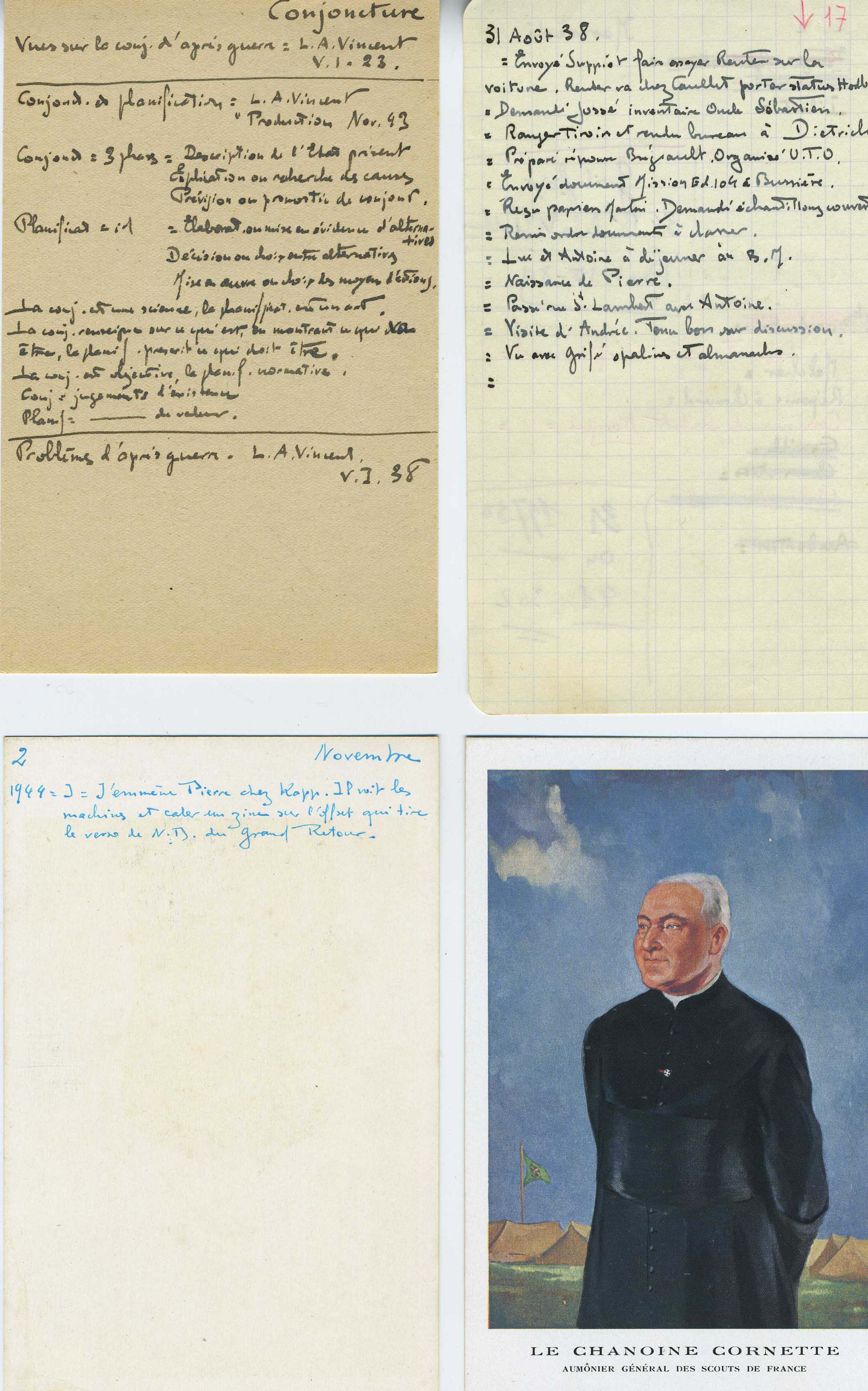
1938. I'm borne. Some cards from my father's cardbox. The box contains a mix of different cards. Some are "word" cards, written either by my father or by his uncle Julien Bouasse, qho probably started this file. My father did not keep on developing this system, but nevertheless kept the box and its content.
1.Card about a word, Conjoncture, probably in 1943
2. One page from a diary. 8/31/1938. I'm borne. Just one line in a card... :-)
3.Diary page.
11/2/1944. "I take Peter with me at Kapp (*a printer firm near Paris). P. sees the machines and the settling of a zinc on the offset machine which will print the back side of N.D. du Grad Retour.
4. Backside of the precedent card. During the war, paper was rare, and we used cards printed in excess some years before).
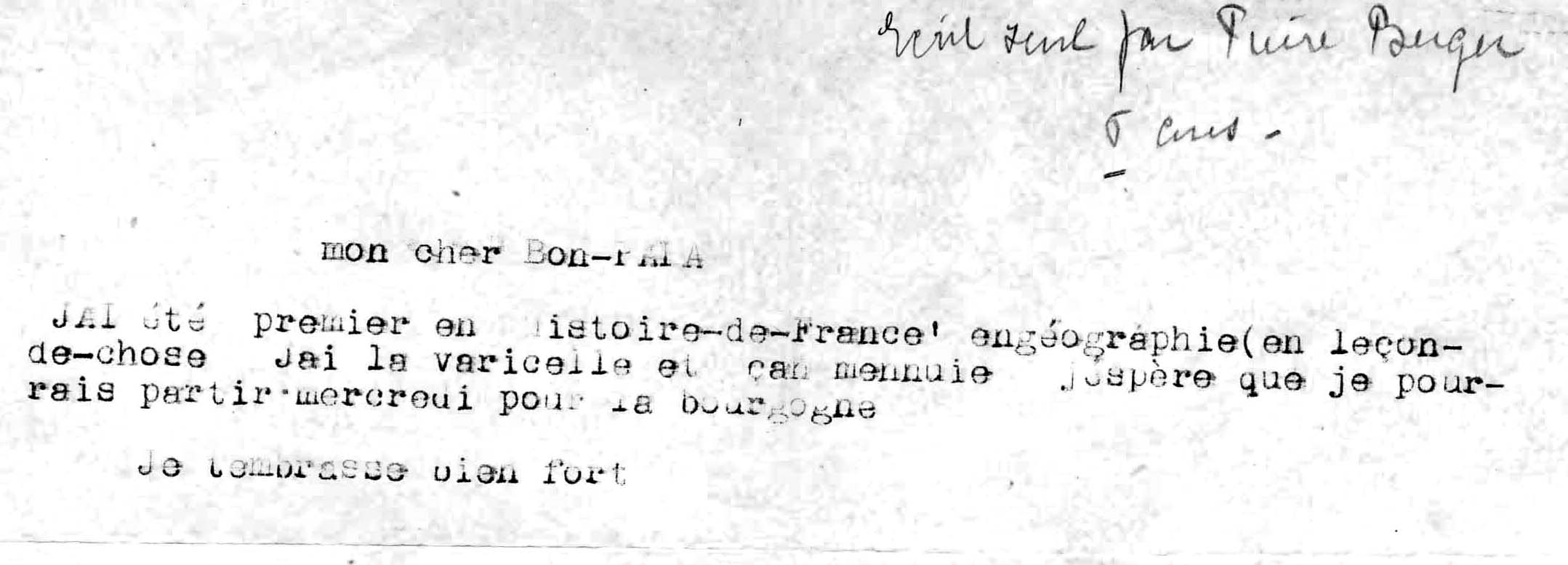 .
. 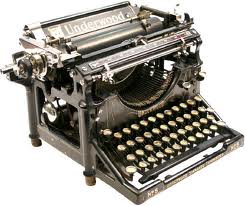
.1945c. My first text on a typewriter (Underwood? or Remington, 1930's model). Nearly this machine (photo taken from Google).
I build a first set of cards file proabably when 10 years old, on postal cards backs (see above; but I discarded them later). Went to the wastebin at around 13,after a retreat which recommended us to free ourselves from useless things.
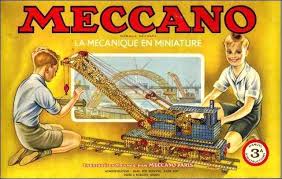 1940's. My father and elder brother were, of had been, Meccano fans.Si did I. It has a philosophical facet: you can build the whole world from a set of standard parts. Coupling that with the universlit Christian motto "gather toghether in one all things in Christ" sew early in my mind a global minframe of total reconstruction. In 2014, that can be transposed to bits for Meccano parts, and to the cloud for Christ (with my apologies to believers).
1940's. My father and elder brother were, of had been, Meccano fans.Si did I. It has a philosophical facet: you can build the whole world from a set of standard parts. Coupling that with the universlit Christian motto "gather toghether in one all things in Christ" sew early in my mind a global minframe of total reconstruction. In 2014, that can be transposed to bits for Meccano parts, and to the cloud for Christ (with my apologies to believers).
1953. Les polars. My first paper of some length. Very probably on the same typewriter as above.
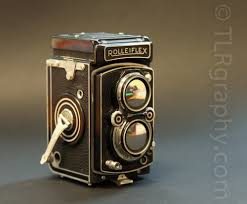 1955c. First "serious" photographs with my father's Rolleiflex. (picture from
tlrgraphy).
1955c. First "serious" photographs with my father's Rolleiflex. (picture from
tlrgraphy).
First TV in my grandmother's bedroom.
1956. I begin to build a coherent data systems at 18, writing everything on 21.27 forms, and binding them with a mobile sheet system used for accountancy documents.
1959.
During my military service, this system would have been much too bulky. Then I write my diary on 21.27, but folded in two.
Durging the same period, going from France to French Congo by sea, a 21 days travel, I prepare it by buying a portable typewriter and a typing method. That will be very useful for me all my life, even today, more than 50 years later, whey typing this paper.
Towards the end of my service, I discovered latex (or similar) glues, and their efficiency for binding. Then, coming back home, I took all my mobile sheet files and bound them into sort of books (with poor appearance).
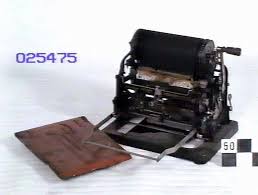 . 1960. Roneo. On this kind of machine I printed my first long text (150 copies). I had to prepare a stencil (s sort of serigraphic document) for each page, with a typewriter for text and a vibrating stylus for images.
Binding led me to discover latex glues, which I used for binding the copies, and later extended to all my paper document sets.
. 1960. Roneo. On this kind of machine I printed my first long text (150 copies). I had to prepare a stencil (s sort of serigraphic document) for each page, with a typewriter for text and a vibrating stylus for images.
Binding led me to discover latex glues, which I used for binding the copies, and later extended to all my paper document sets.
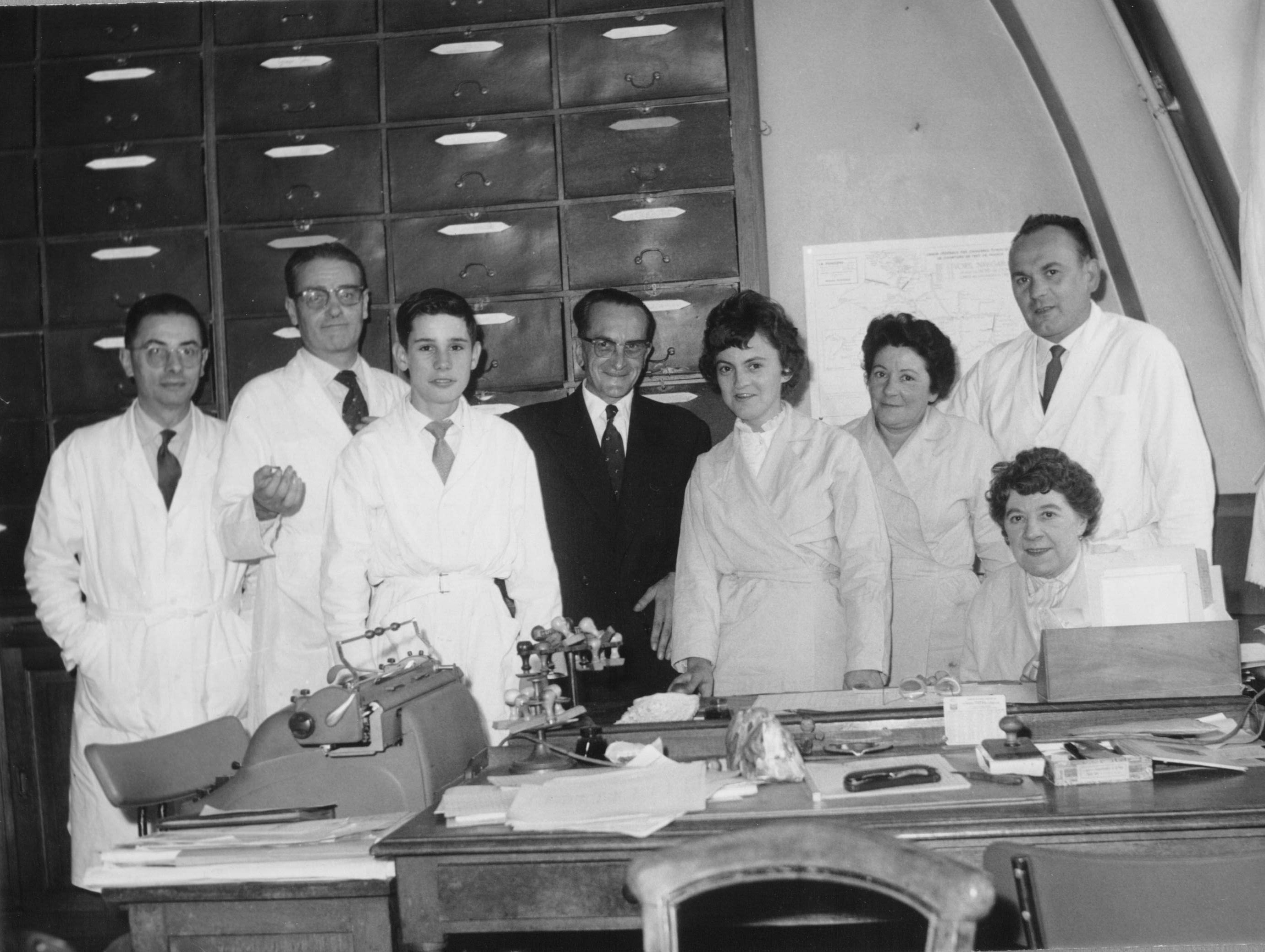 .1961.. A typical office in my insurance company.
.1961.. A typical office in my insurance company.
There I discover punched cards machinery (at first very old models, then more modern, then a a computer project (I left before its implementation).
I try to prepare a sort of handbook for all the administrative tasls. Someting lihe what will be ISO 9000.standards in the 1990's.
I try also to visualize quantitative data.
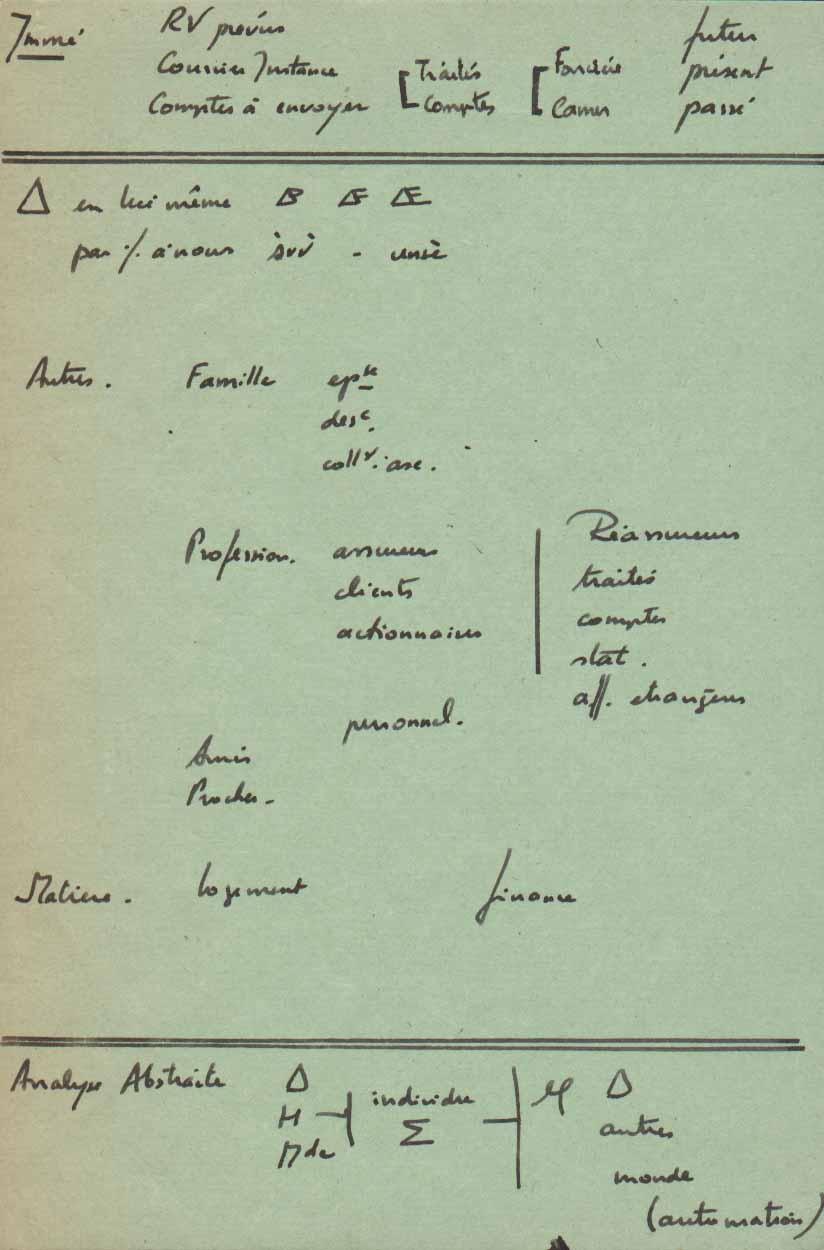 . 1963c. A form for regular "examen de conscience"
. 1963c. A form for regular "examen de conscience"
 .1963. First idea of a general network. The local connected set.
.1963. First idea of a general network. The local connected set.
1964. My first professional paper about computers, in La Réassurance.
I decide to write only with a Rotring india ink pen.
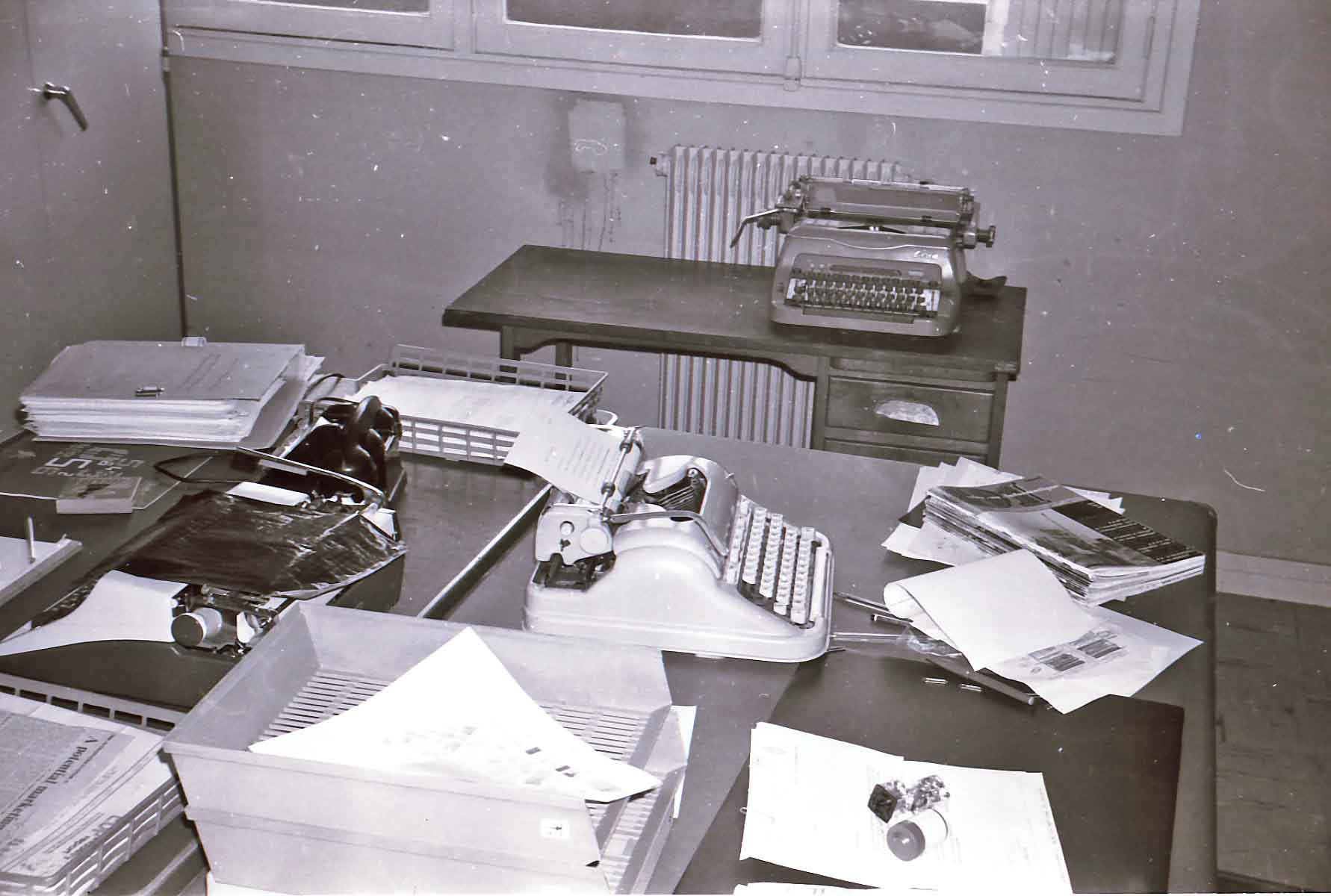 .1967. I am now a journalist. My workplace at 0.1. Informatique. No other machine than a telephone and my typewriter (I am the only one journaliste who types by himself).
.1967. I am now a journalist. My workplace at 0.1. Informatique. No other machine than a telephone and my typewriter (I am the only one journaliste who types by himself).
I buy a correct Kodak photo camera. And begin to store methodically my negarives.
About at that time, due to lack of spaces in our flat, for the first time I throw books in the garbage can.
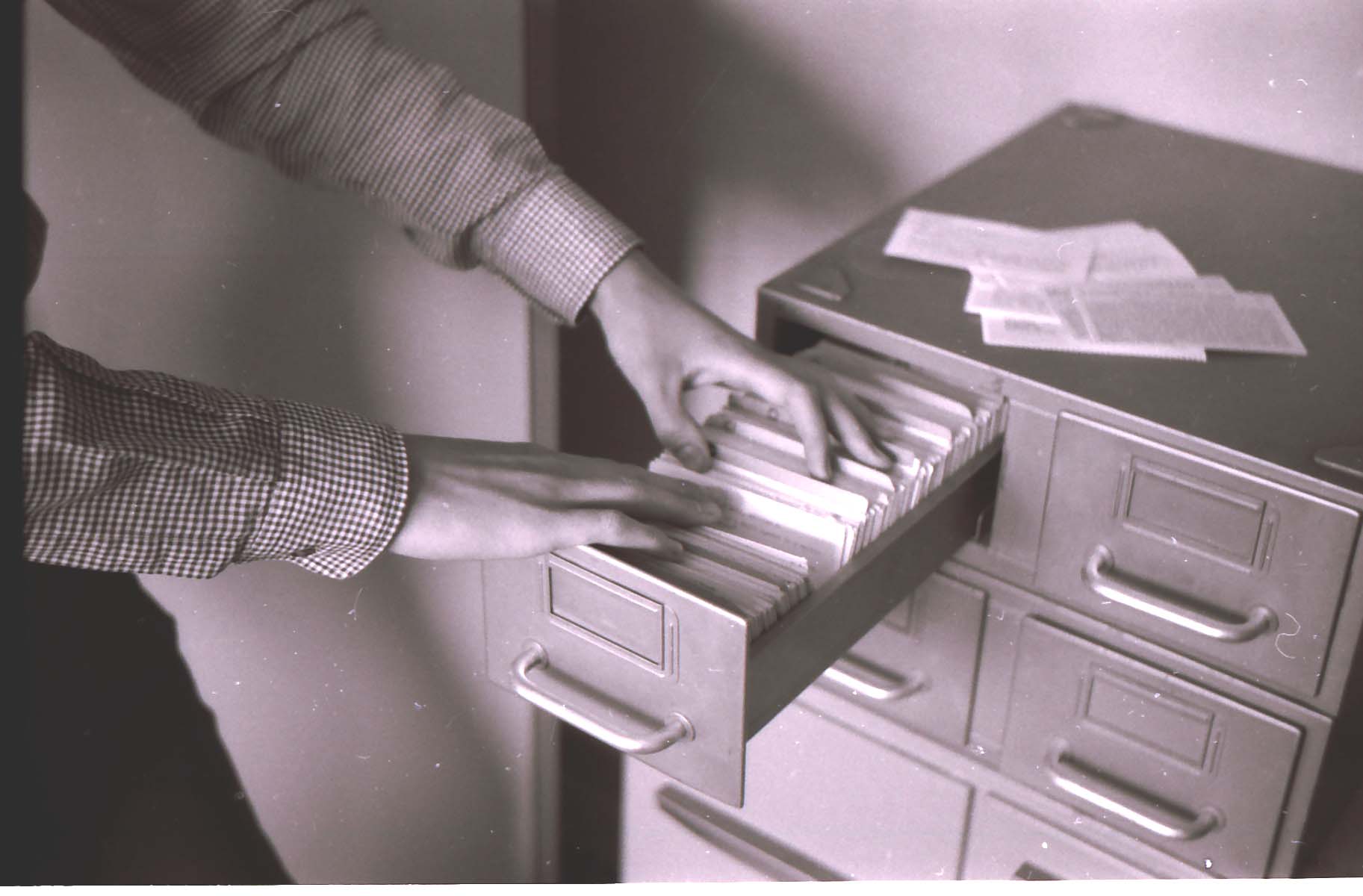 .1967. Mechanical system for susbscribes addressing.There is also a very primitive copier. Then a Telex machine for getting News agencies messages.
.1967. Mechanical system for susbscribes addressing.There is also a very primitive copier. Then a Telex machine for getting News agencies messages.
1968. We prepare a directory of French computer users (corporations only). To do that we use a Telex typewriter to store data on punched tape (not a frequent solution at this time; but punched tape was much less expensive than punched cards).
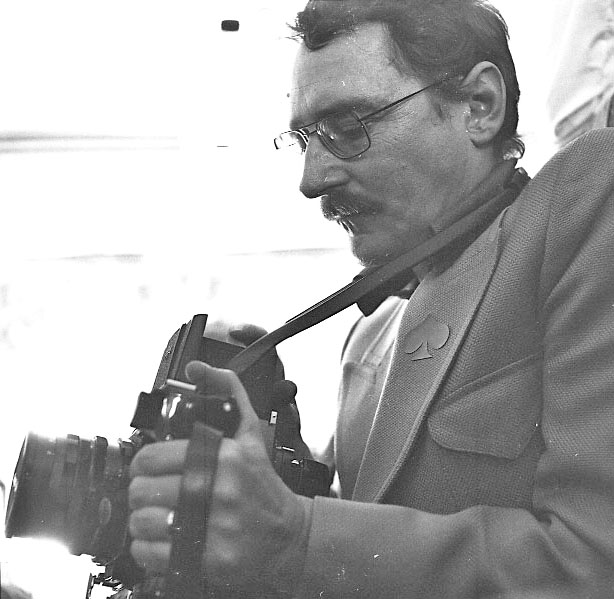 .1970's A free-lance photographer with film camera. Most frequently black and white, since color printing is too expensive.
.1970's A free-lance photographer with film camera. Most frequently black and white, since color printing is too expensive.
Sometimes I unse my own camera, or my father's Hasselblad.
This year, we get our first TV set at home.
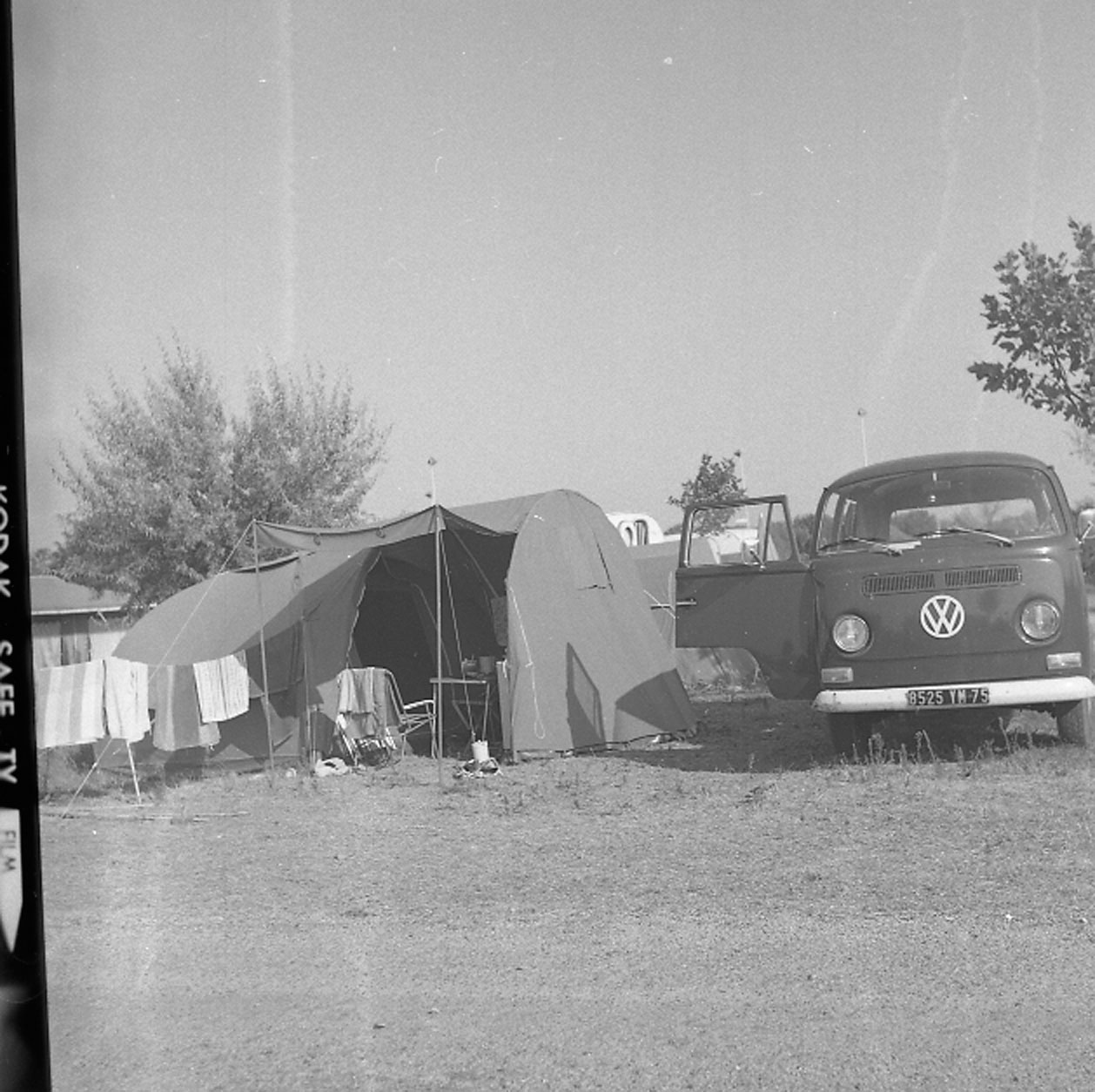 1972. For family uses, I buy a Volkswagen Combi. It dream of fitting a library, computing and communications facilities in it. Everything everywhre the wind pushes. It will become a practical reality with the laptops, some 20 years later.
1972. For family uses, I buy a Volkswagen Combi. It dream of fitting a library, computing and communications facilities in it. Everything everywhre the wind pushes. It will become a practical reality with the laptops, some 20 years later.
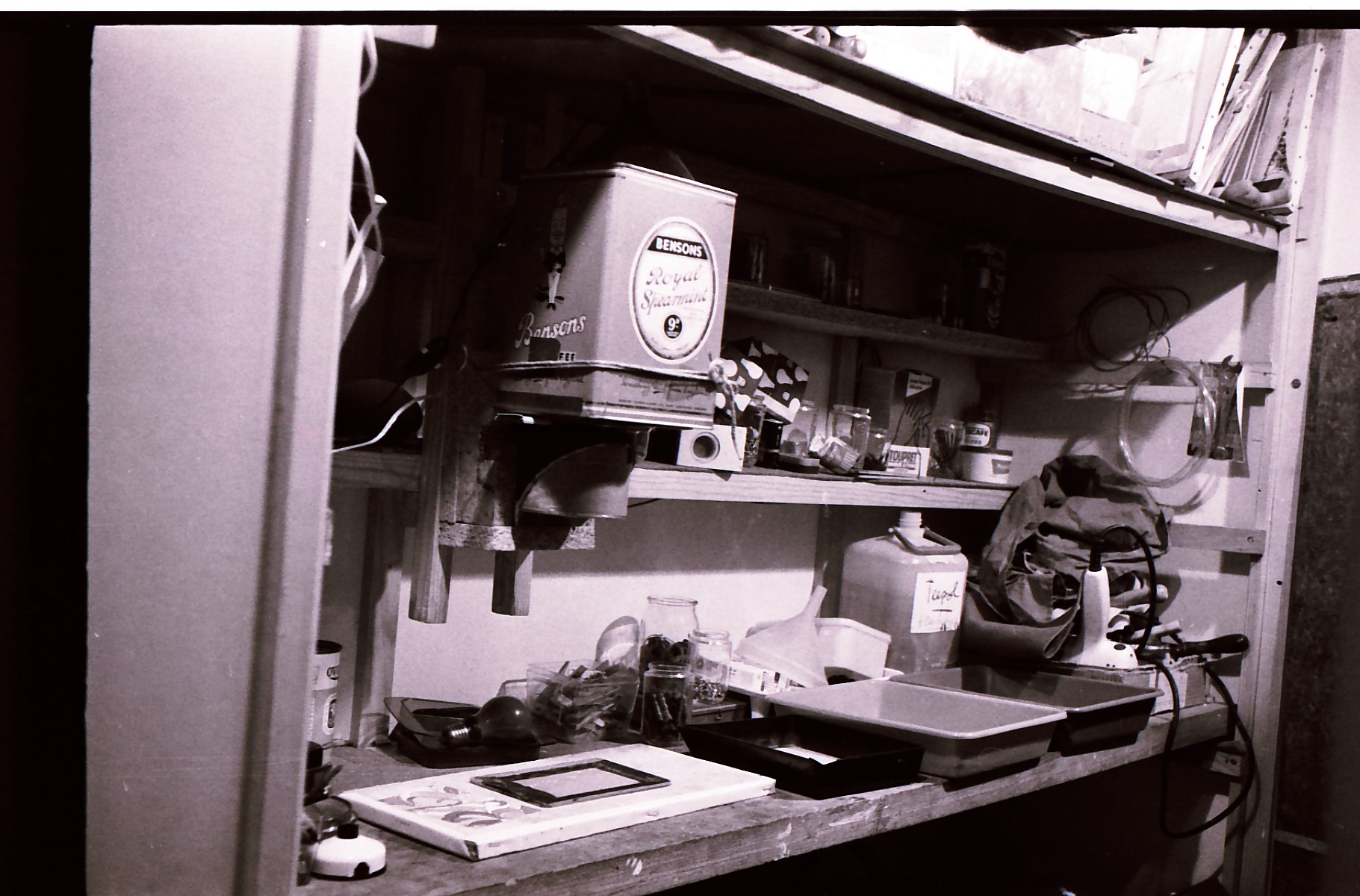 .
.
 .1969c. My DIY photo enlarger and print preparation lab at home in a small storeroom.
.1969c. My DIY photo enlarger and print preparation lab at home in a small storeroom.
My cooperation with Jean-Louis Le Moigne reinforces my interest for "systemics".
A6 files for concepts.
I save paper collections.
Many photos. I begin to save methodically the negatives.
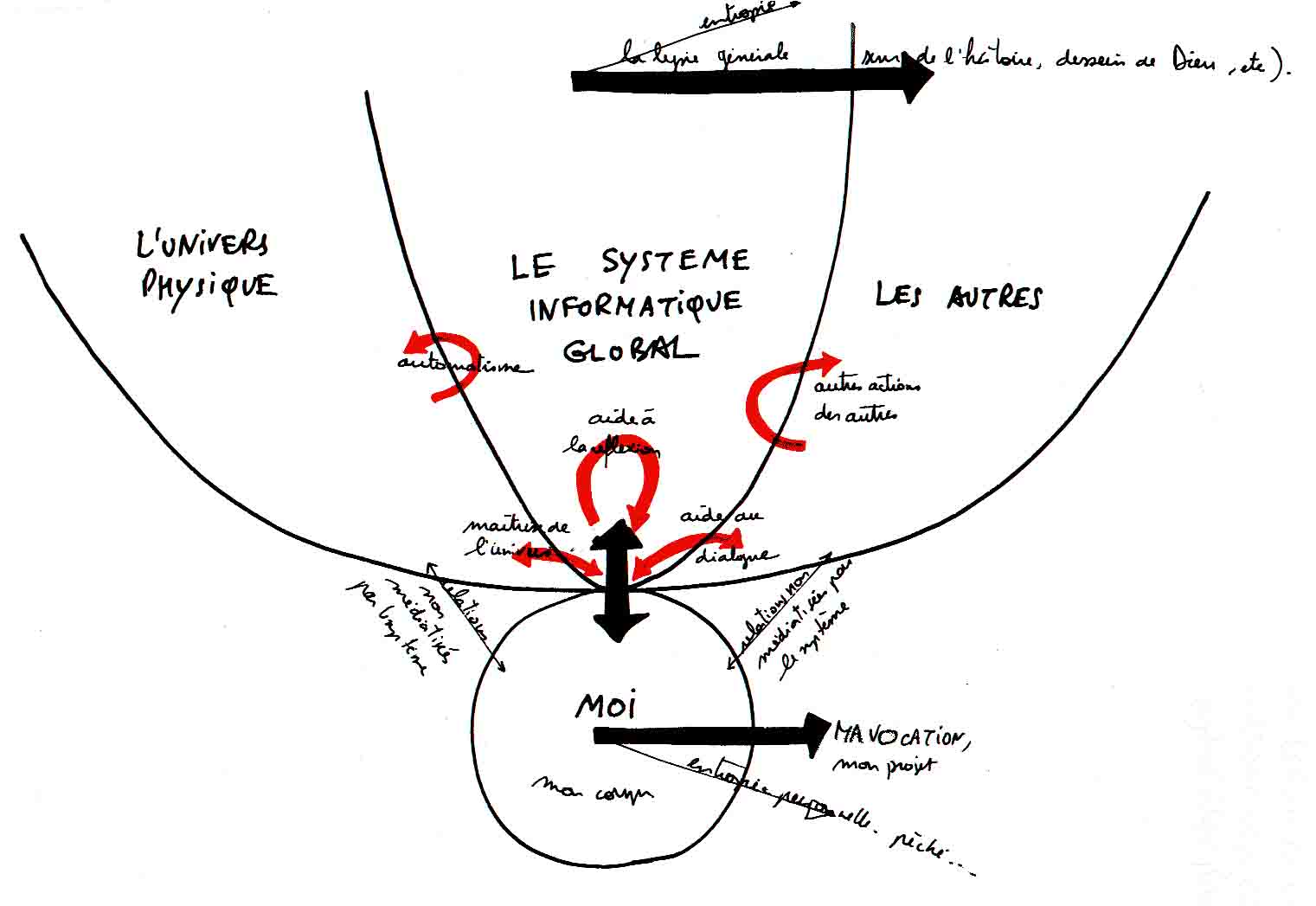 .1971. The world seen from the workplace
.1971. The world seen from the workplace
I have the opportunity to write some lines Cobol. At this time, the programmers work on paper forms, that are then transferred on punched cards par "perfo" operators.
The MIS (Managemnet integrated systems) is trendy.
1972c. I add recapitulative indexes in the December issue of Informaique et Gestion.
Notes about The computer convergence (not published, they were mainly an exploratory text).
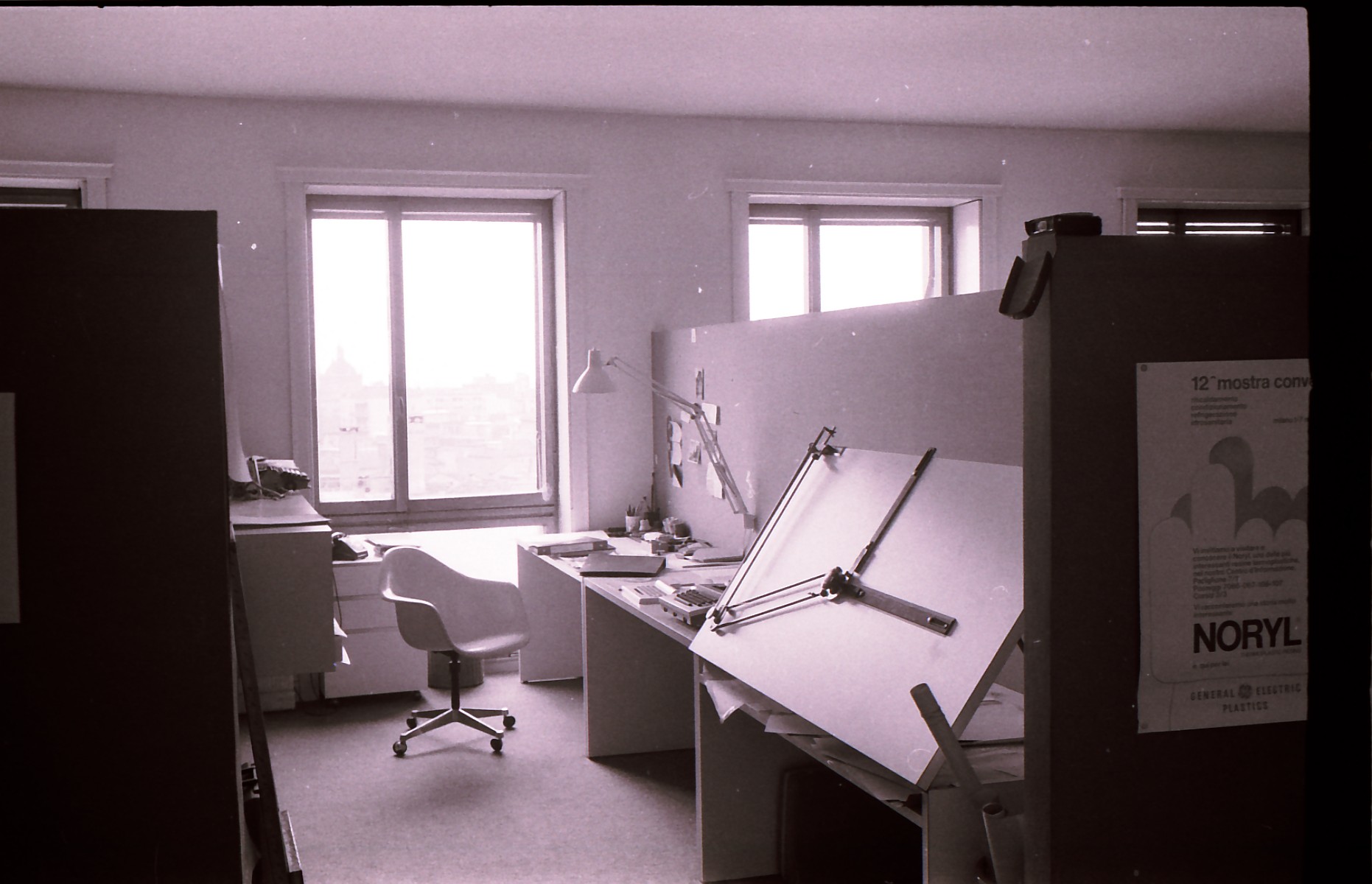 .1973c. Drawing desks (at a designer's office, Milano)
.1973c. Drawing desks (at a designer's office, Milano)
1973c. I build a paper cards (A6) file of concepts.
I bein to create a file of all new computer products, using blank punched cards. With figures published annually.
I publsih annually a state of the computer industry in France.
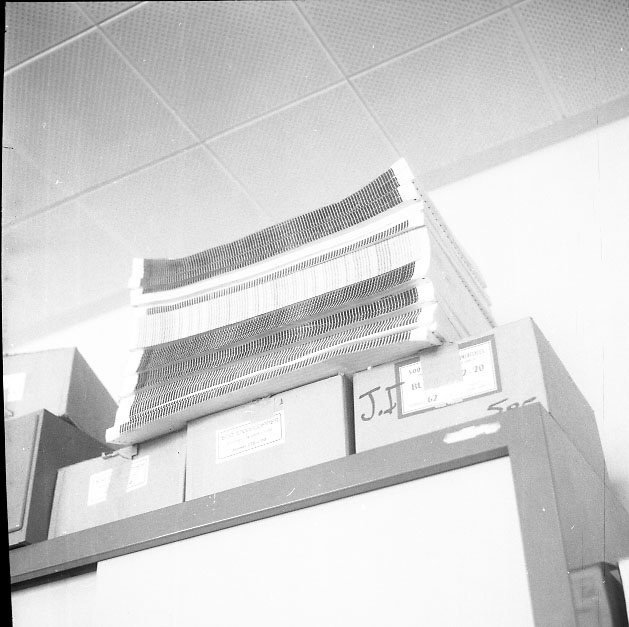 .1972c. "Listings" on an cupboard top
.1972c. "Listings" on an cupboard top
1973c. I write a text (not published) about La systémique. Its "modern" orientation is in contradiction with the "post-modern" mood of the period.
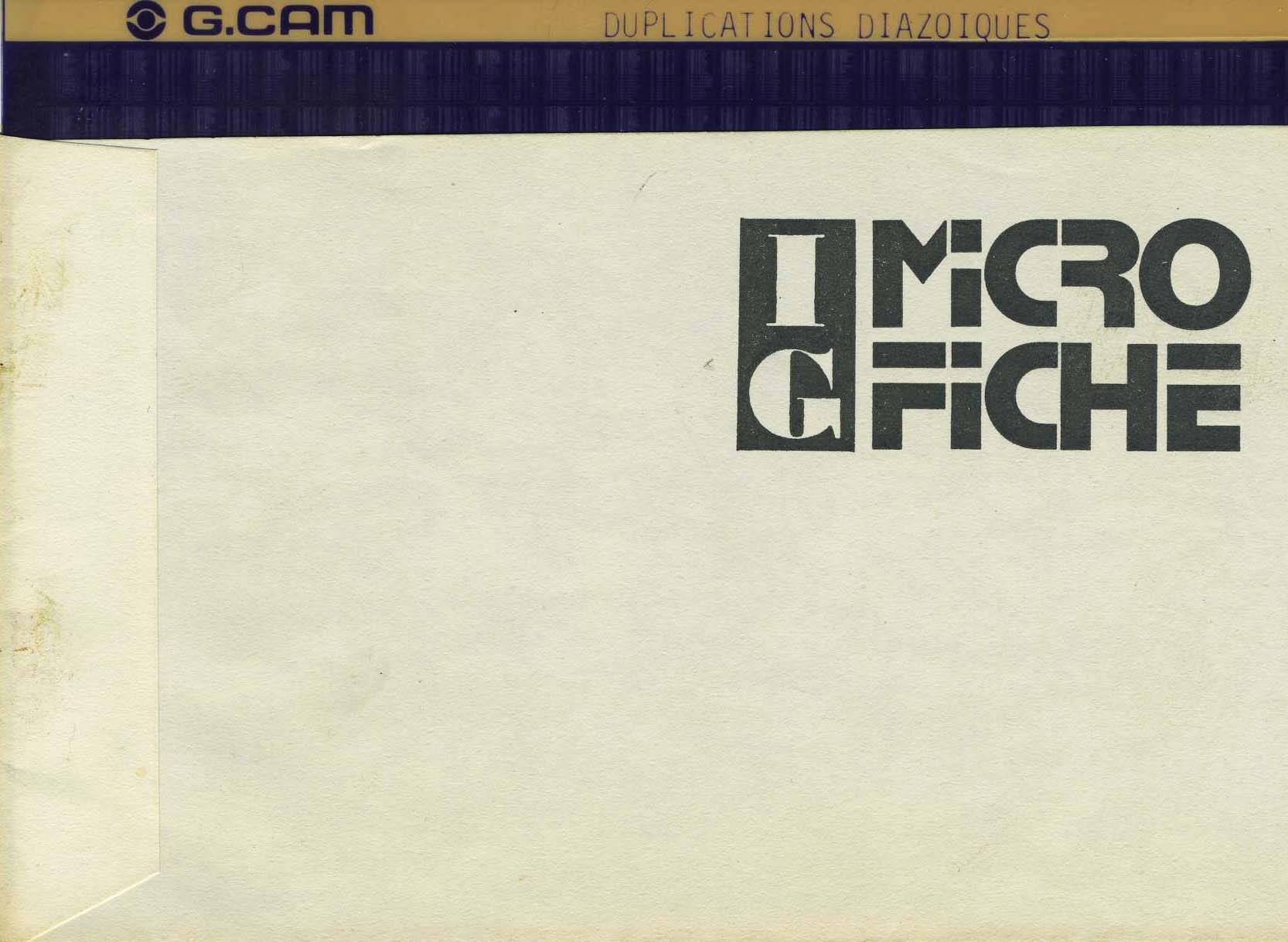 1974. Microfiche. We try a pulication of Informatique et Gestion on this media. I do some attemps to creation and edition. But without success.
1974. Microfiche. We try a pulication of Informatique et Gestion on this media. I do some attemps to creation and edition. But without success.
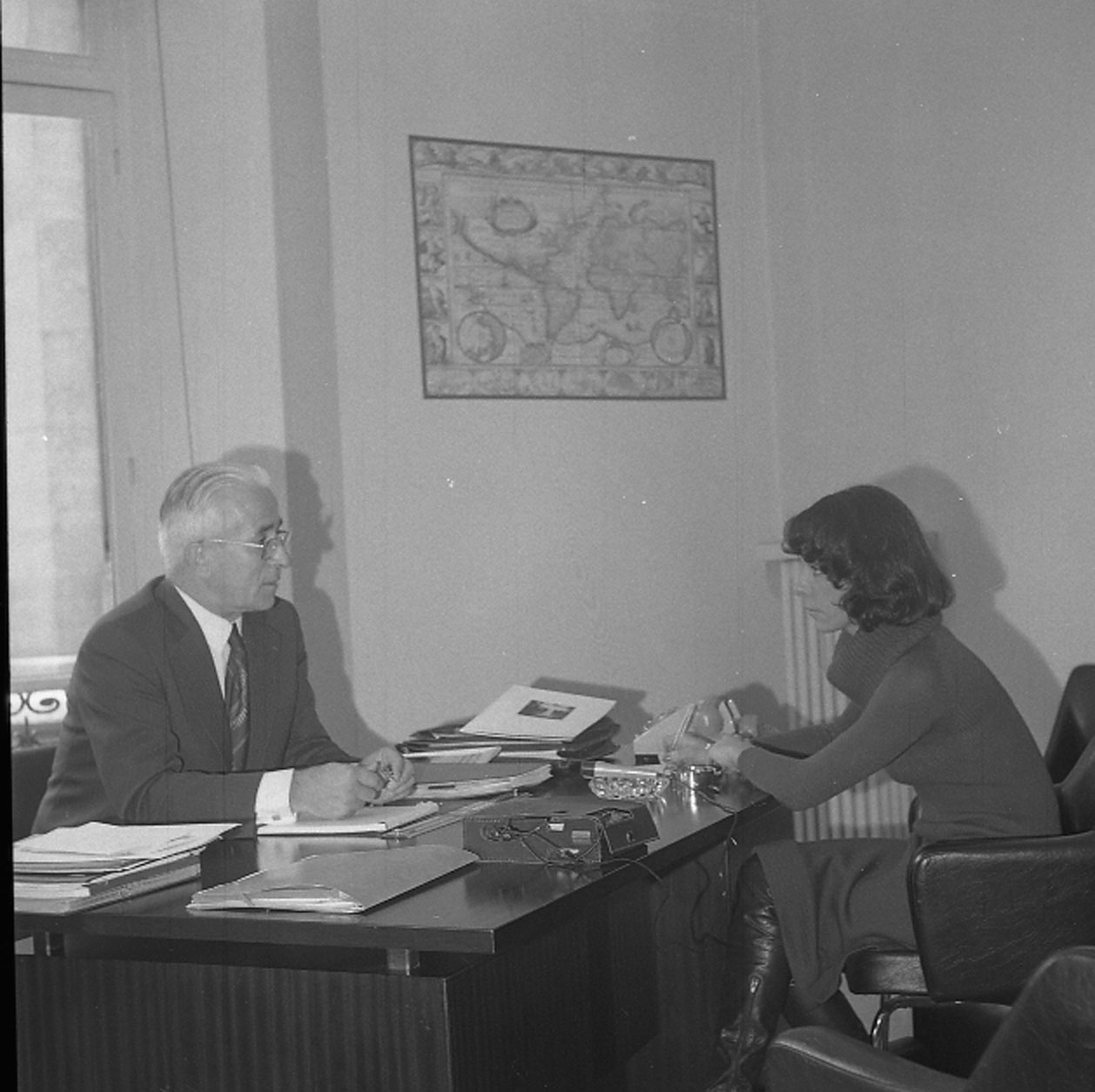 .1975c. Interview of a CEO with a tape recorder
.1975c. Interview of a CEO with a tape recorder
1976. A short novel Une ame qui bouge. A (soft) thriler novel about a world where normally information only is supposed to travel. It's judged as poor by some people who read it. Then I discard the idea of becoming a SF writer.
1977c. First lines in Basic on an Olivetti desktop wih 8" floppies. Application: survey perusal.
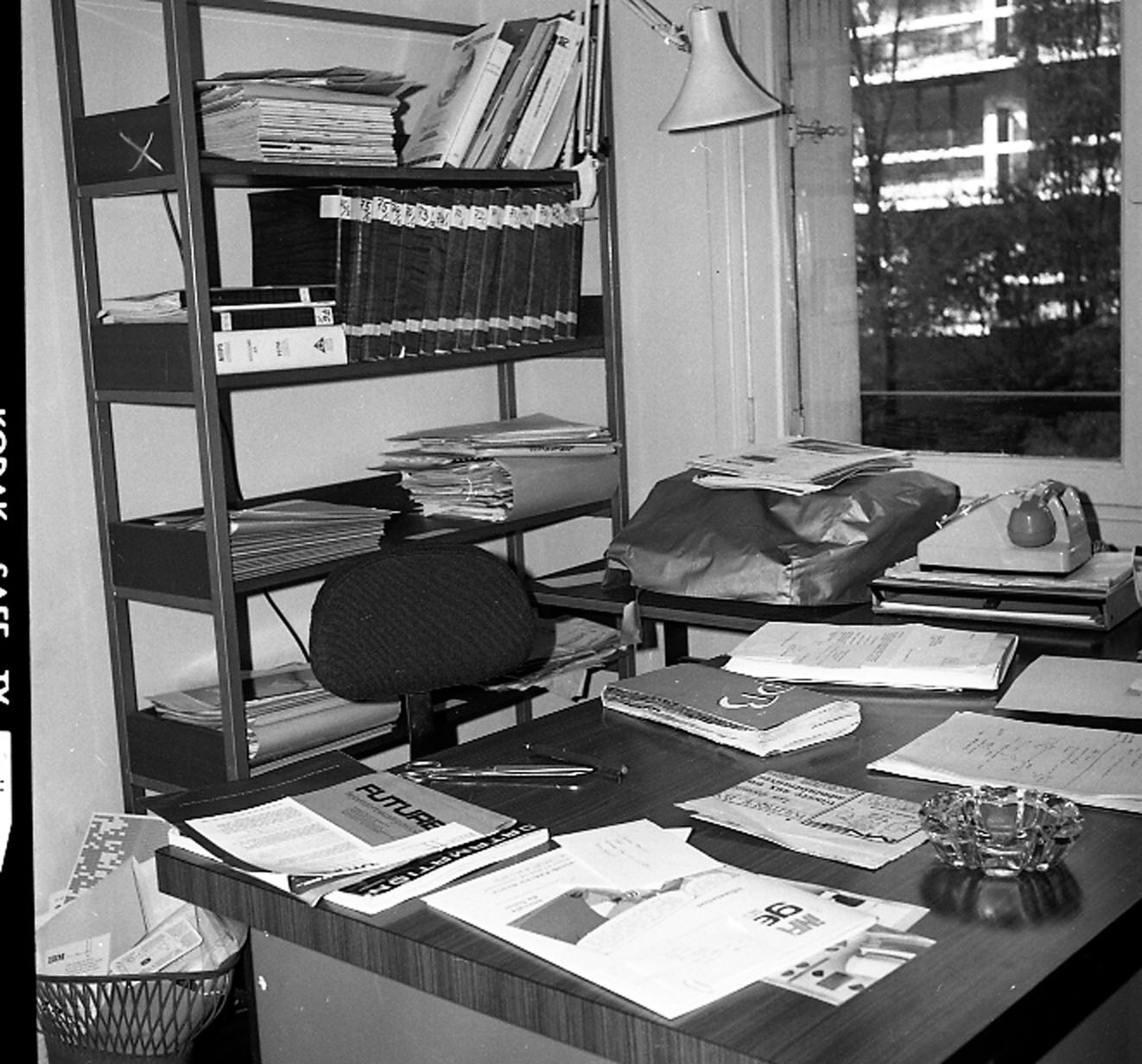 .1979. My workplace at Informatique et Gestion. Still nothing more than typewriter and telephone.
.1979. My workplace at Informatique et Gestion. Still nothing more than typewriter and telephone.
I get an automatic phone number composer, using special punched cards.
I get a typewriter with audio cassettes storage. Very noisy. But allows some level of corrections.
I write notes about "perfect information", which somehow announces the information situation of the 21th century. They are not published. Partly because they are abstract as well as in advance on their time (René Thom, for instance, finds them not plausible), partly because I am not yet familiar with conferences jurying processes, and present only a draft.
1979c. I gather oll the the printed photos of my in-laws and build a set of album pages (special format, comparable to A4, but not exactluy of the same size.
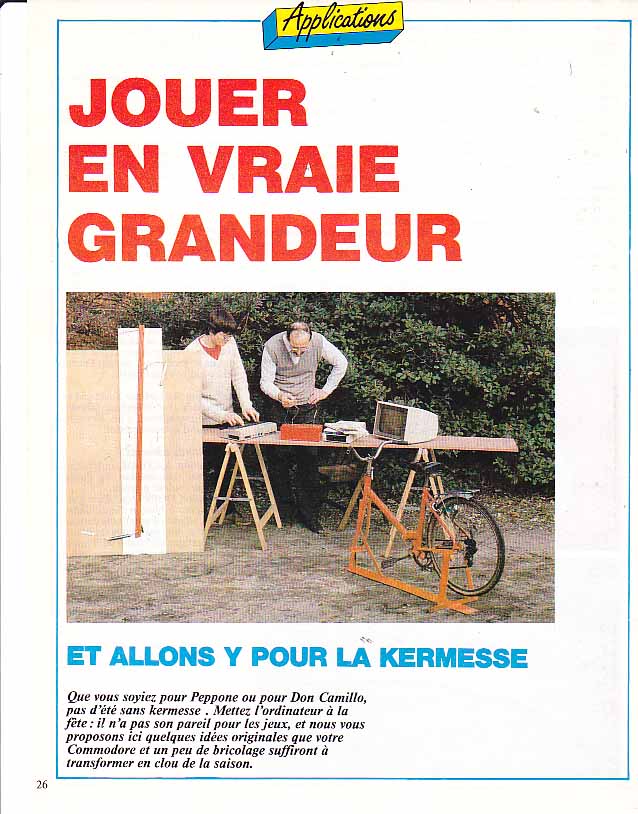 . 1985. At home. Programming for fun (games on Commodore 64. Basic programming and an external control card. My paper in Commodore Magazine.
. 1985. At home. Programming for fun (games on Commodore 64. Basic programming and an external control card. My paper in Commodore Magazine.
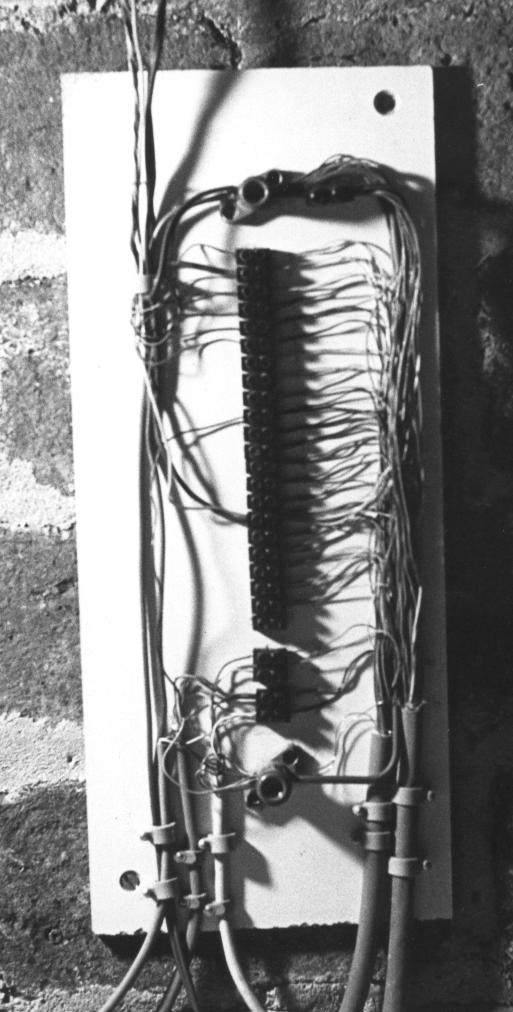 .1979. I build a network in my house. Connected to my "Max" robot. Later to the Commodore 64 microcomputer. A tentative "domotic" system, with some sensors and possibility of report printing. By the way, it opened privacy issues.
.1979. I build a network in my house. Connected to my "Max" robot. Later to the Commodore 64 microcomputer. A tentative "domotic" system, with some sensors and possibility of report printing. By the way, it opened privacy issues.
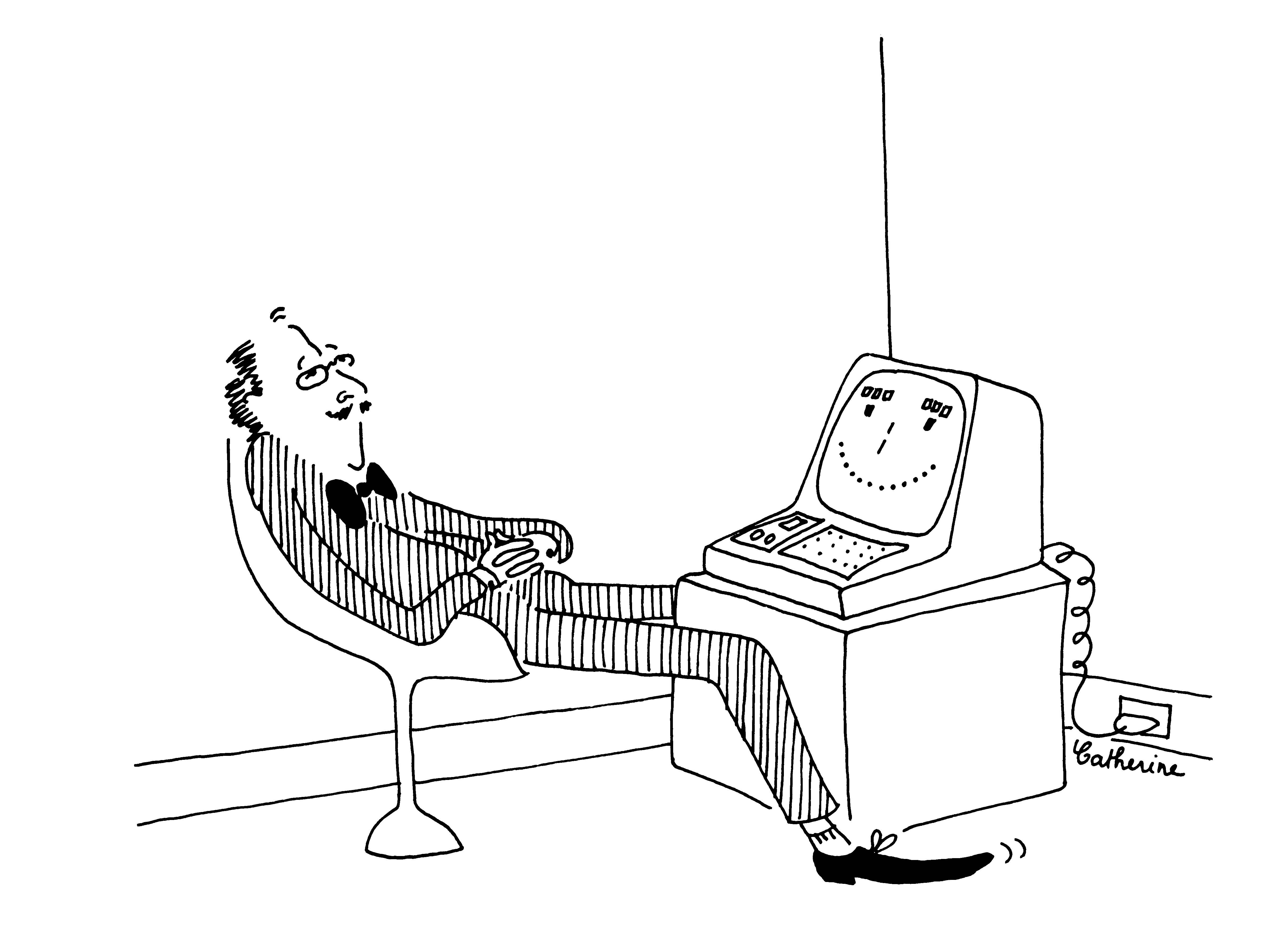 .1979. First programm on a Commodore Pet . A drawing by Catherine Beaunez.
.1979. First programm on a Commodore Pet . A drawing by Catherine Beaunez.
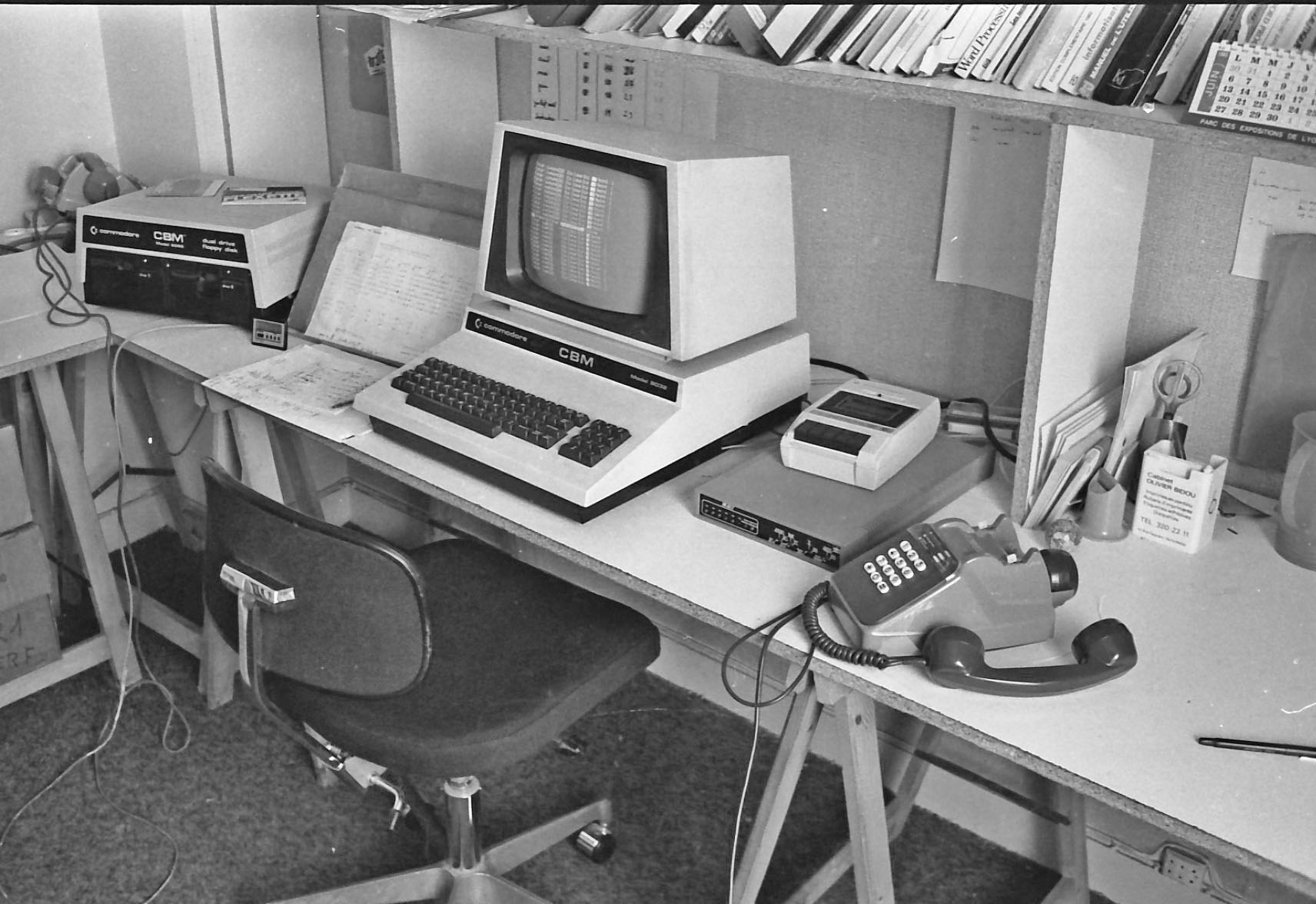 .1982. Commoore 8000, with 16KB RAM. Desktop for text processing and invoicing. At left, a double 8" floppy disk reader. At right, a modem for transmission to the printer.
.1982. Commoore 8000, with 16KB RAM. Desktop for text processing and invoicing. At left, a double 8" floppy disk reader. At right, a modem for transmission to the printer.
Software: propietary. Basic programming.
Applications. . For text processing, and text marking aimed to the printer's photocomposer. A forerunner of HTML, invoicing and accountancy.
Perenniality. No data or text could be transferred on later computers. .
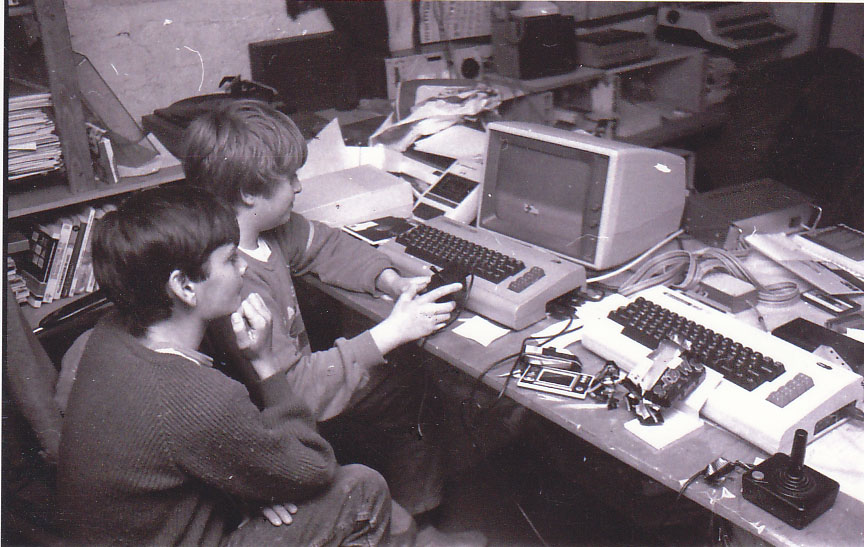 .1982c. Desktops in my basement. Commodore Vic20 and 64. With storage on audio-cassettes, then on floppy disks. Programming in Basic.
.1982c. Desktops in my basement. Commodore Vic20 and 64. With storage on audio-cassettes, then on floppy disks. Programming in Basic.
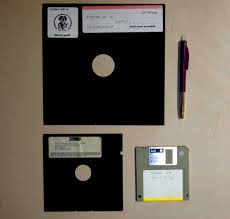 . From 1972 to 2000. The three successive floppy disk formats. (image from HistoireInform website.
. From 1972 to 2000. The three successive floppy disk formats. (image from HistoireInform website.
-
8", 80 kilobytes, then extended 250 kB.
- 5"1/4. 80kB, then extended to 1,2 MB
- 3'1/1, 720kB then extended to 1,5 MB
1982. Minitel. I use it notably to exchange emails with Bertrand Meyer, chief editor of TSI, then working in Santa Barbara (CA). At this time, few people see the powerful potential of Internet.
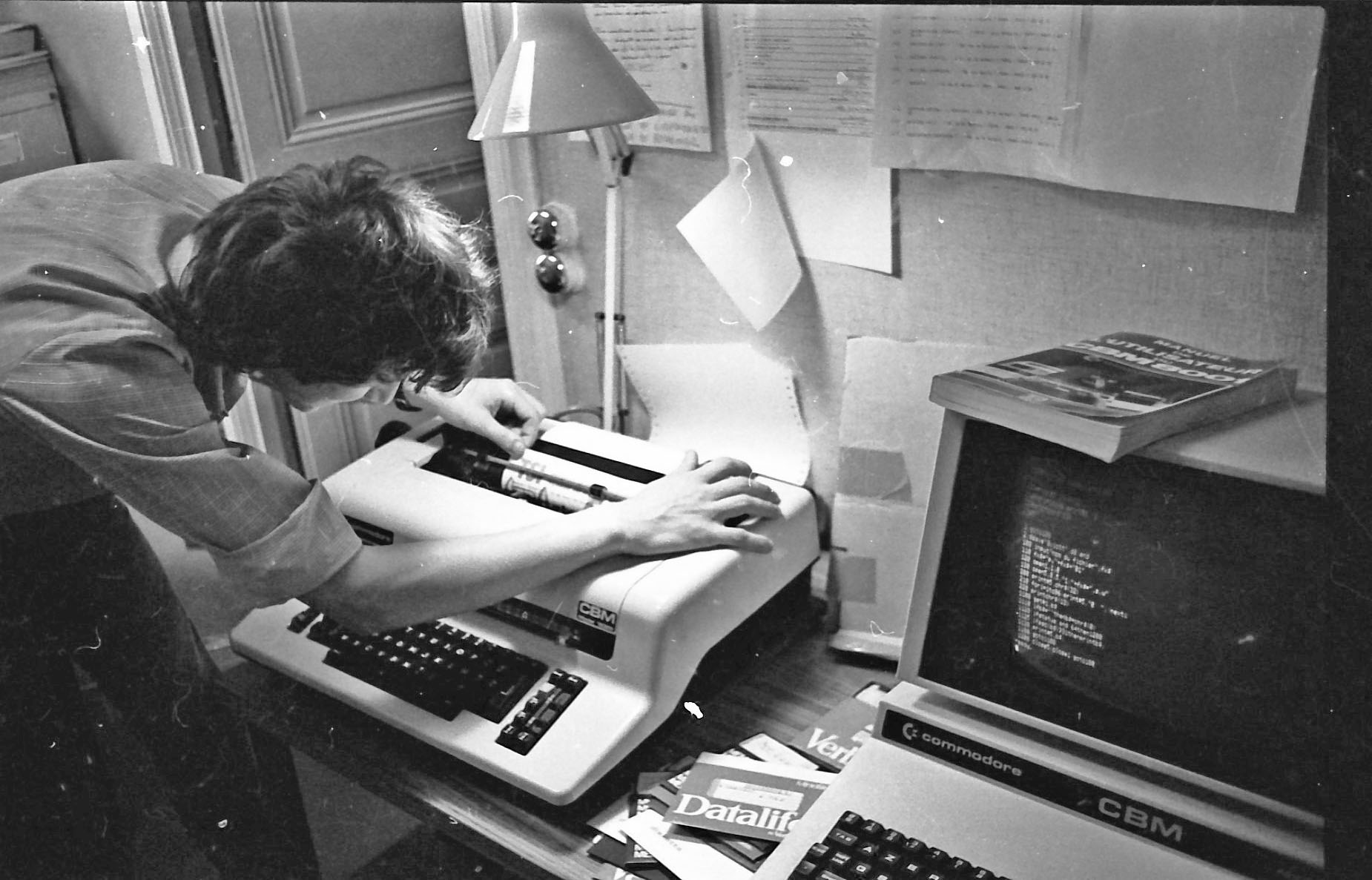 . 1983. Another Commodore at TSI. Here the "daisy" printer.Slow and noisy, but high quality printing for correspondence.
. 1983. Another Commodore at TSI. Here the "daisy" printer.Slow and noisy, but high quality printing for correspondence.
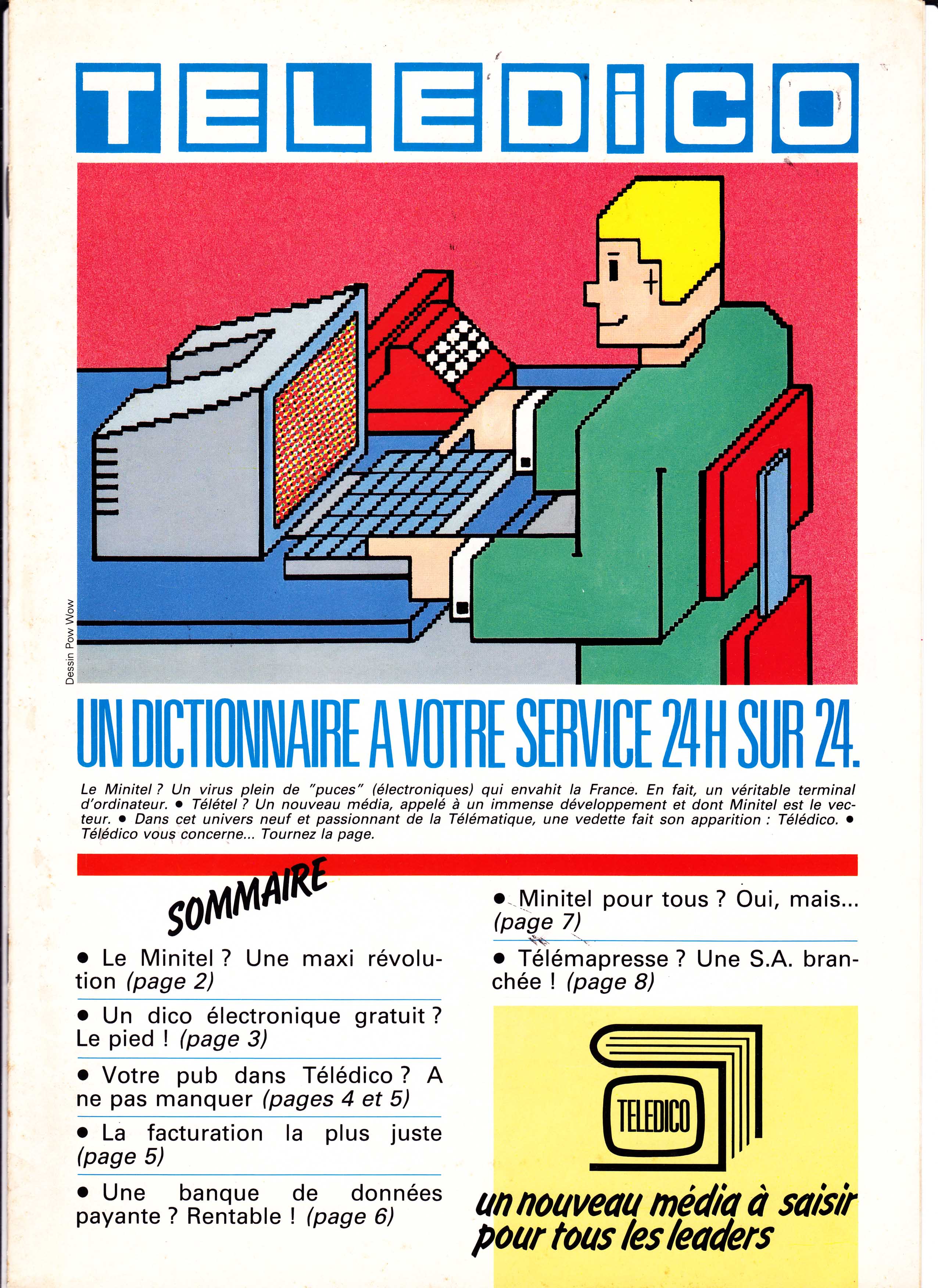 .1983. I found Télépampresse corporaition (SA), with a printer and a service company, to lauch. Télédico. A "website" on Minitel (1984)
.1983. I found Télépampresse corporaition (SA), with a printer and a service company, to lauch. Télédico. A "website" on Minitel (1984)

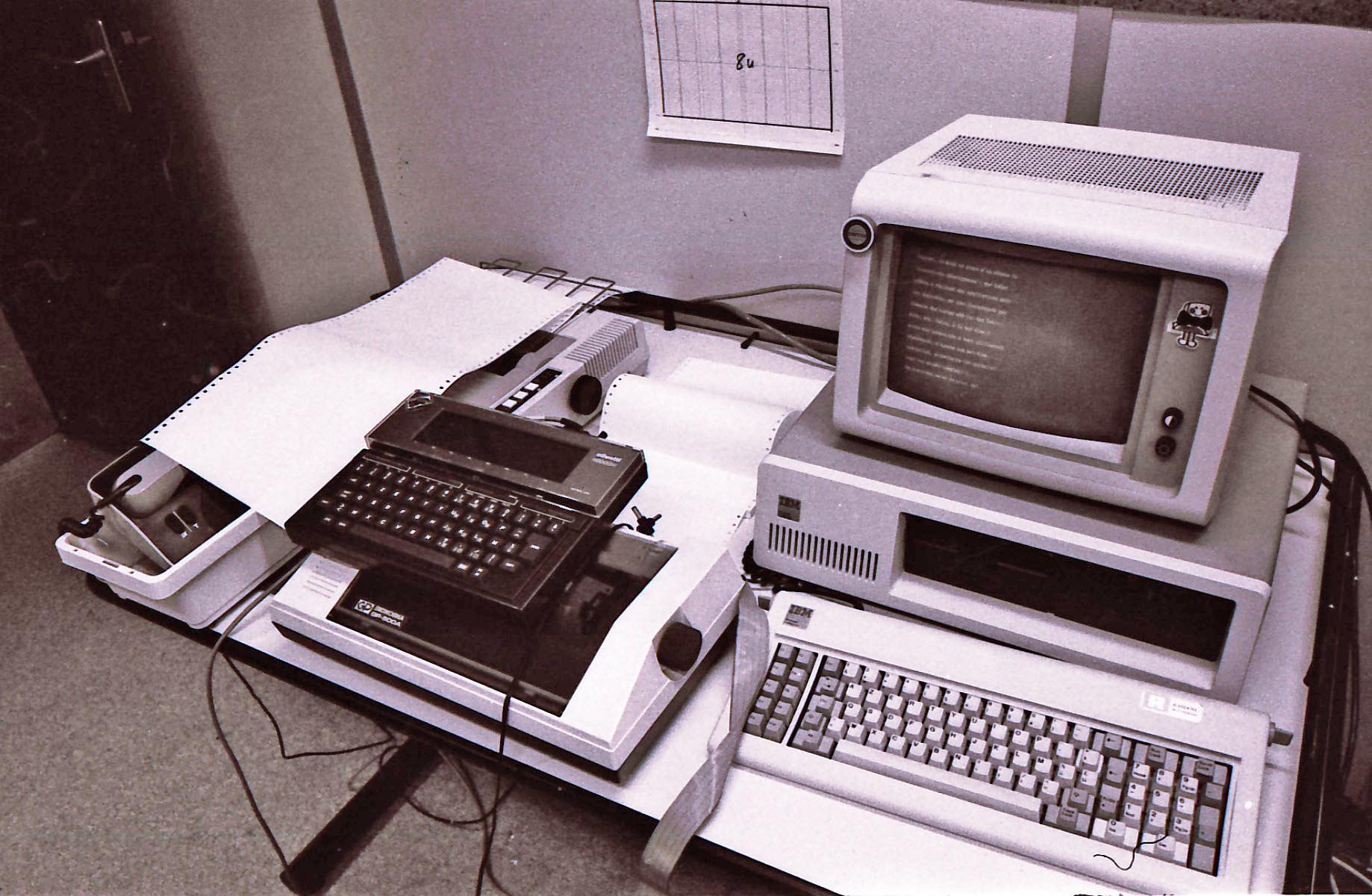 .1985. At Le Monde Informatique. A small Olivetti "laptop" for text writing by the journalists. At right, the editor's desk, where the texts are stransferred to the editorial chain.
.1985. At Le Monde Informatique. A small Olivetti "laptop" for text writing by the journalists. At right, the editor's desk, where the texts are stransferred to the editorial chain.
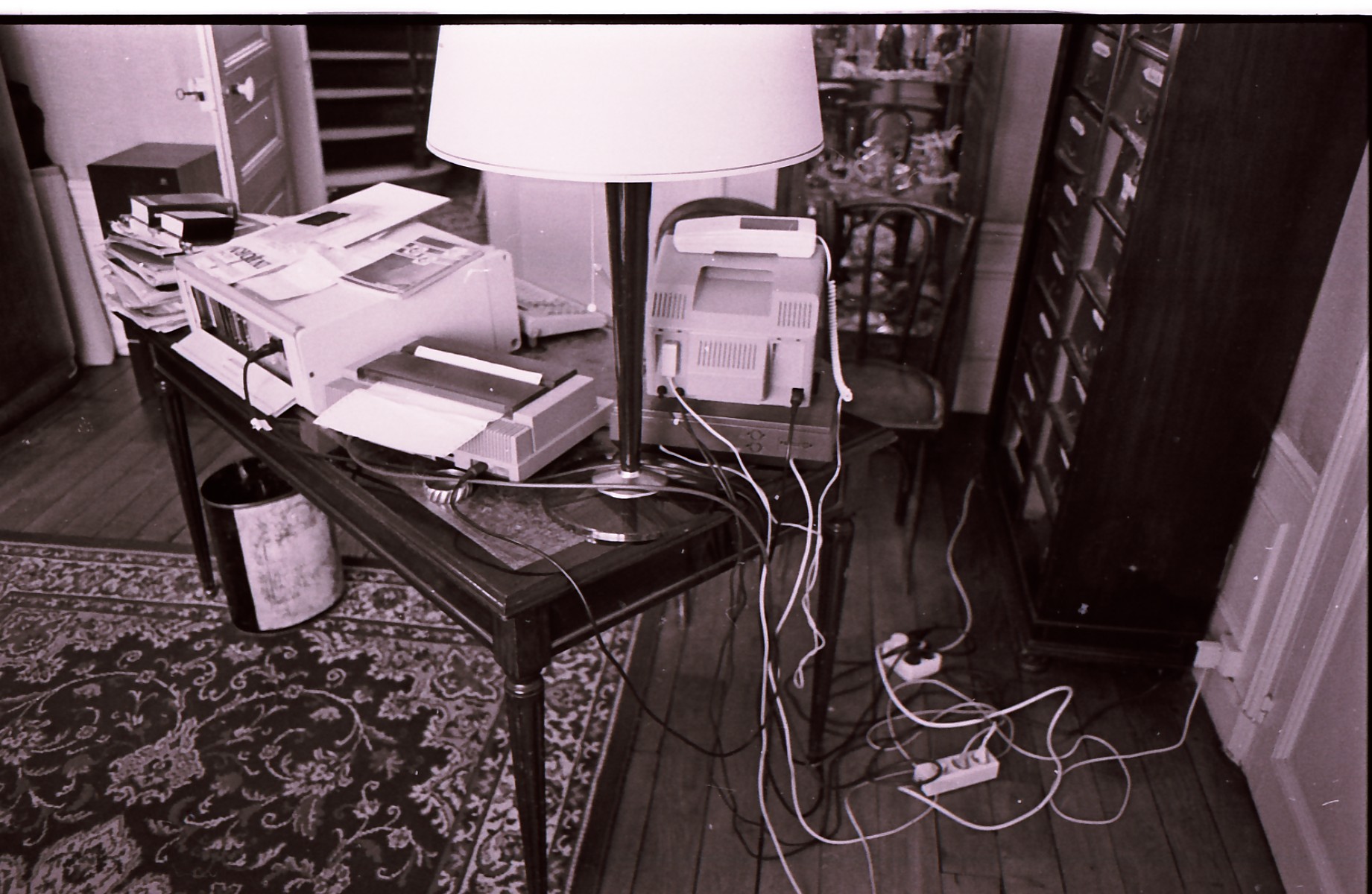 .1987c. My first "portable" (IBM), at home. With a small screen and two. 5"1/4 floppy discs. At left, a Minitel terminal.
.1987c. My first "portable" (IBM), at home. With a small screen and two. 5"1/4 floppy discs. At left, a Minitel terminal.
1987. First paper (not published) about Hypermonde (to be checked)
Around this time, I can use a demo version of a system expert software. Fascinated, by its dynamic aspect. But disillusioned about the results.
 . 1989. PC desktop with floppies and telephone. At LMI Avenue de Neuilly
. 1989. PC desktop with floppies and telephone. At LMI Avenue de Neuilly
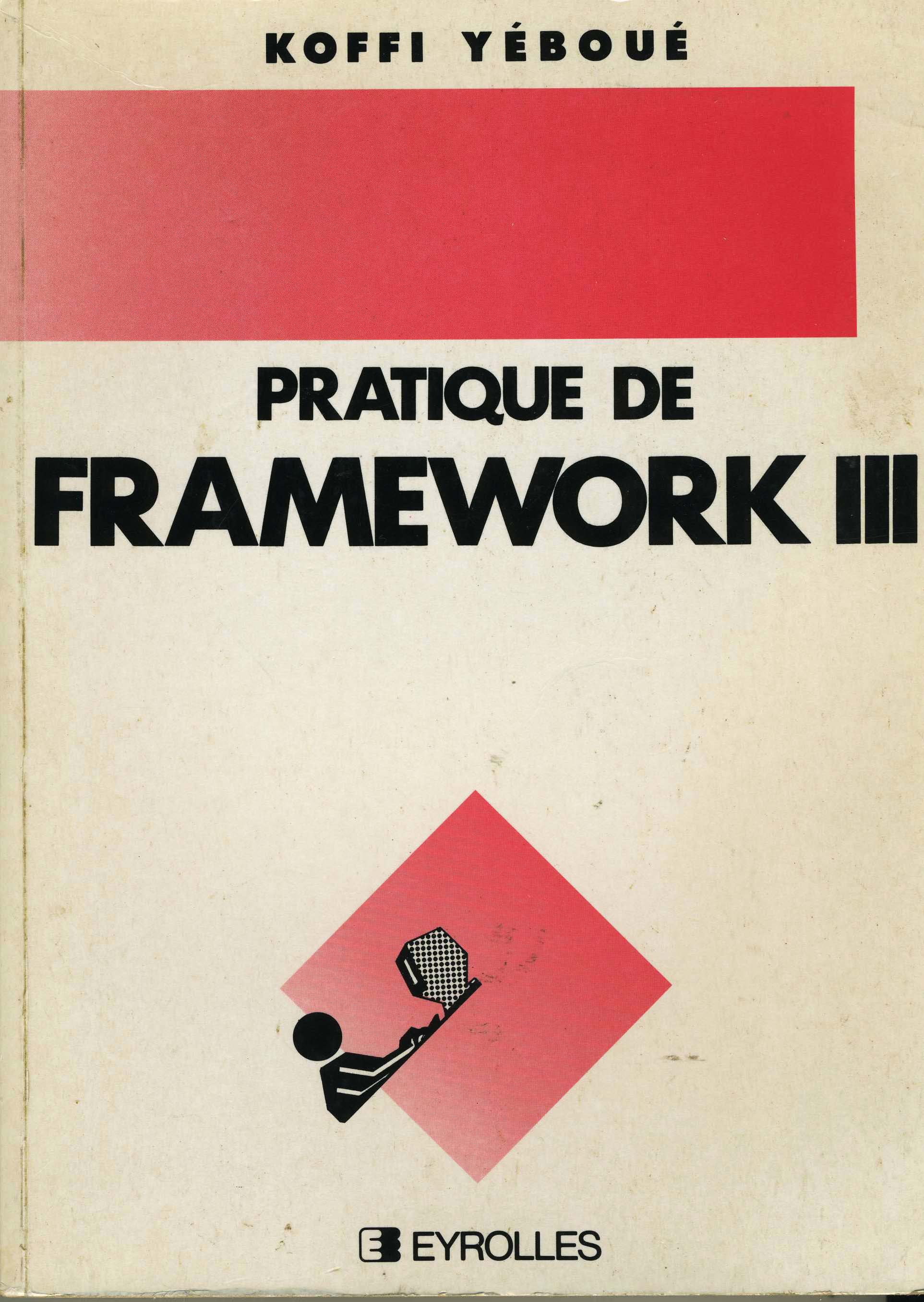
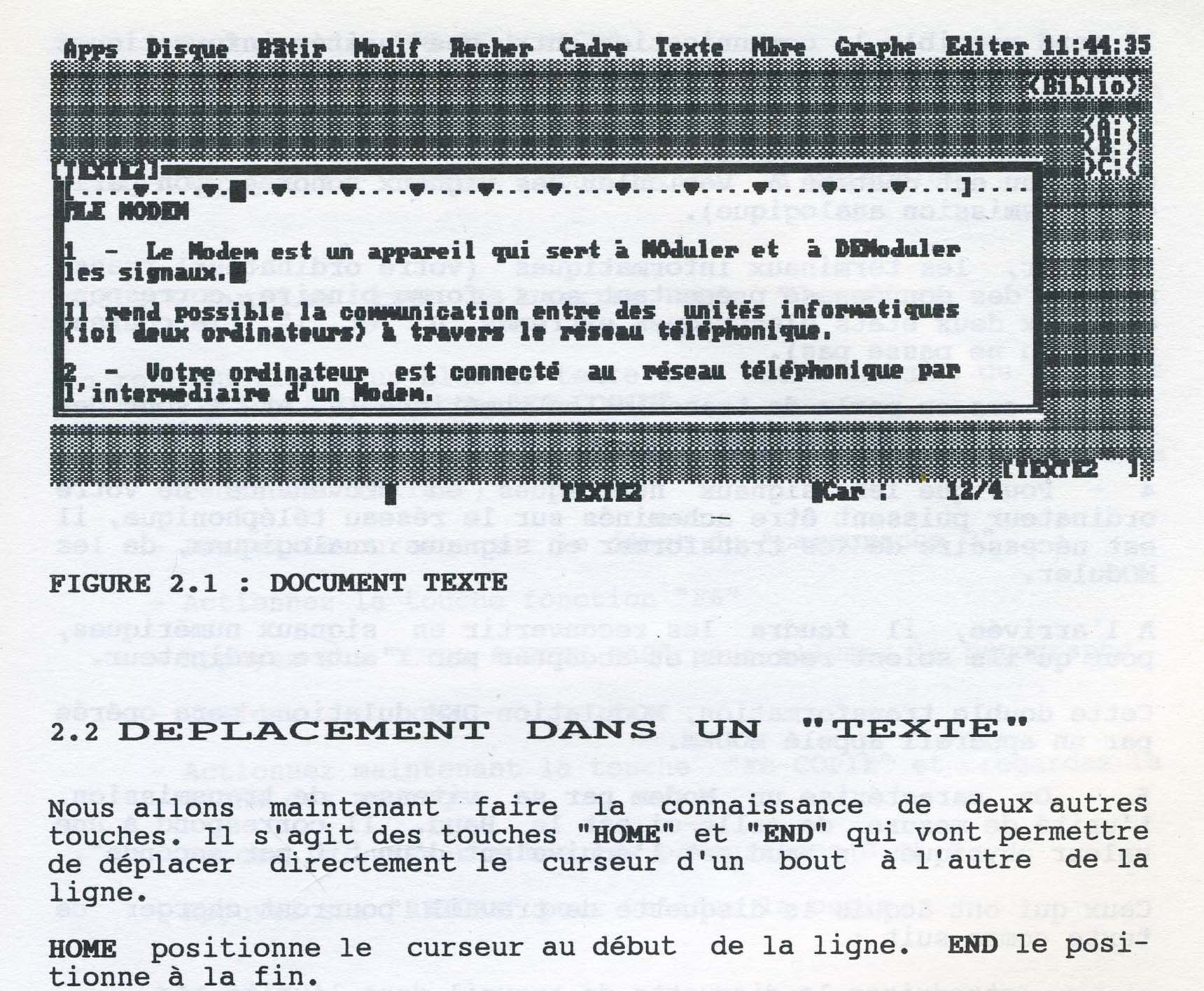 Software : Framework. The first integrated office tool. It will a little later superseded by Microsoft Office.But fortunately, during several monthes, conversion tools were available and I could save my text files of this period.
Software : Framework. The first integrated office tool. It will a little later superseded by Microsoft Office.But fortunately, during several monthes, conversion tools were available and I could save my text files of this period.
Application: text processing
 .1989. Still a lot of paper at my LMI workplace. Mainly paper documentation about computer user corporations.
.1989. Still a lot of paper at my LMI workplace. Mainly paper documentation about computer user corporations.
I begin to create on computer indexes of these files, and of my papers.
I create my General Chronoloy.
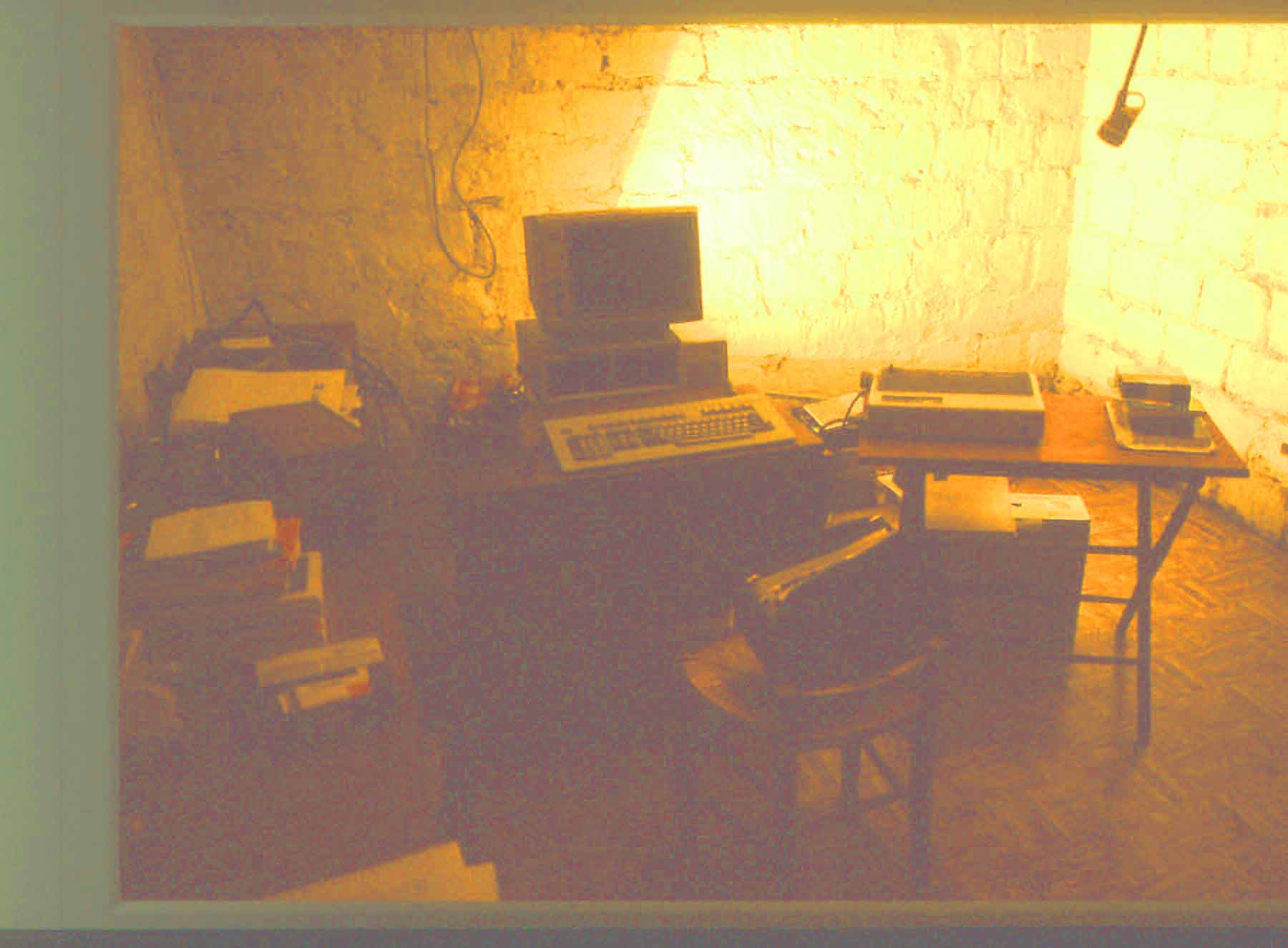 .1989. THL The Transparadigmatic Hyper Laboratory. In my basemaent. use a microfilm reader to make projections Hyper Laboratory. See notes.
.1989. THL The Transparadigmatic Hyper Laboratory. In my basemaent. use a microfilm reader to make projections Hyper Laboratory. See notes.
1990. I write Maintenant l'Hypermonde, with long presentation of integrated information systems.
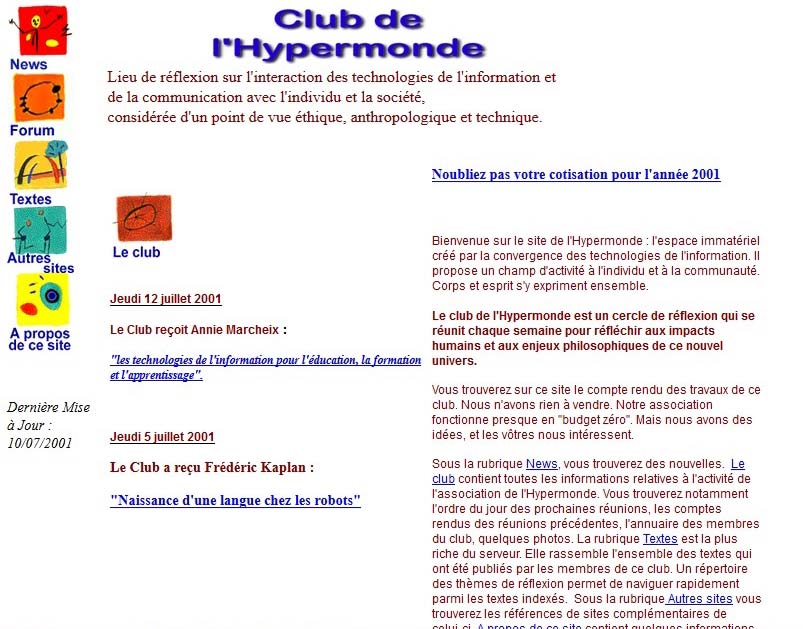 1991. Creation of a website for Club de l'Hupermonde. Here the home page as it was in 2001, and you can today reach at http://diccan.com/Hypermonde/default.htm. The server was hosted in a mainframe computer.
1991. Creation of a website for Club de l'Hupermonde. Here the home page as it was in 2001, and you can today reach at http://diccan.com/Hypermonde/default.htm. The server was hosted in a mainframe computer.
Around 1990, I buy a Toshiba laptop. See Mes folles amours...
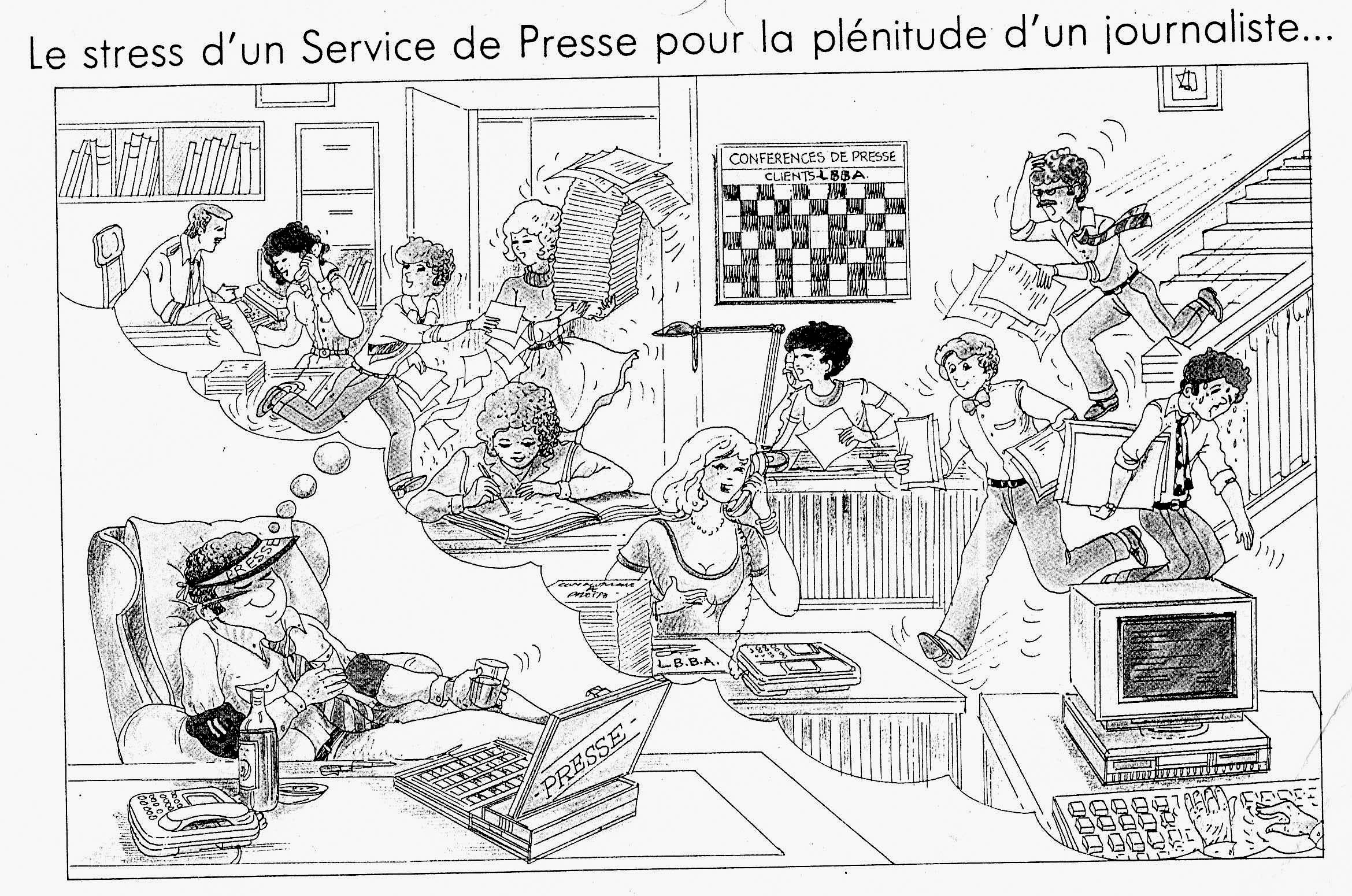 .1992c. The press conference process, see by a Press Agency. Still mainly paper.
.1992c. The press conference process, see by a Press Agency. Still mainly paper.
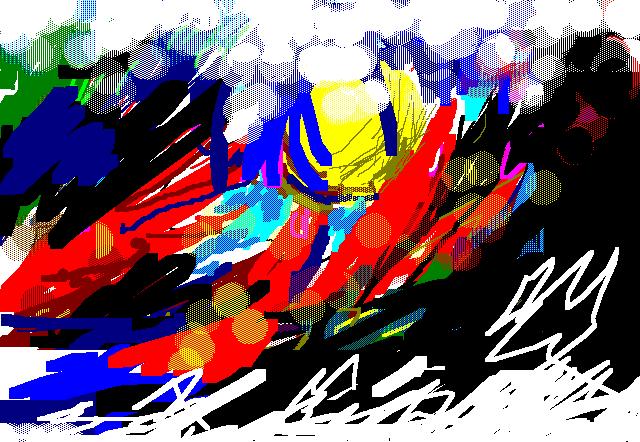 .1992c. First drawing on a PC, with Windows Paint. I use it also to edit some photographies.
.1992c. First drawing on a PC, with Windows Paint. I use it also to edit some photographies.
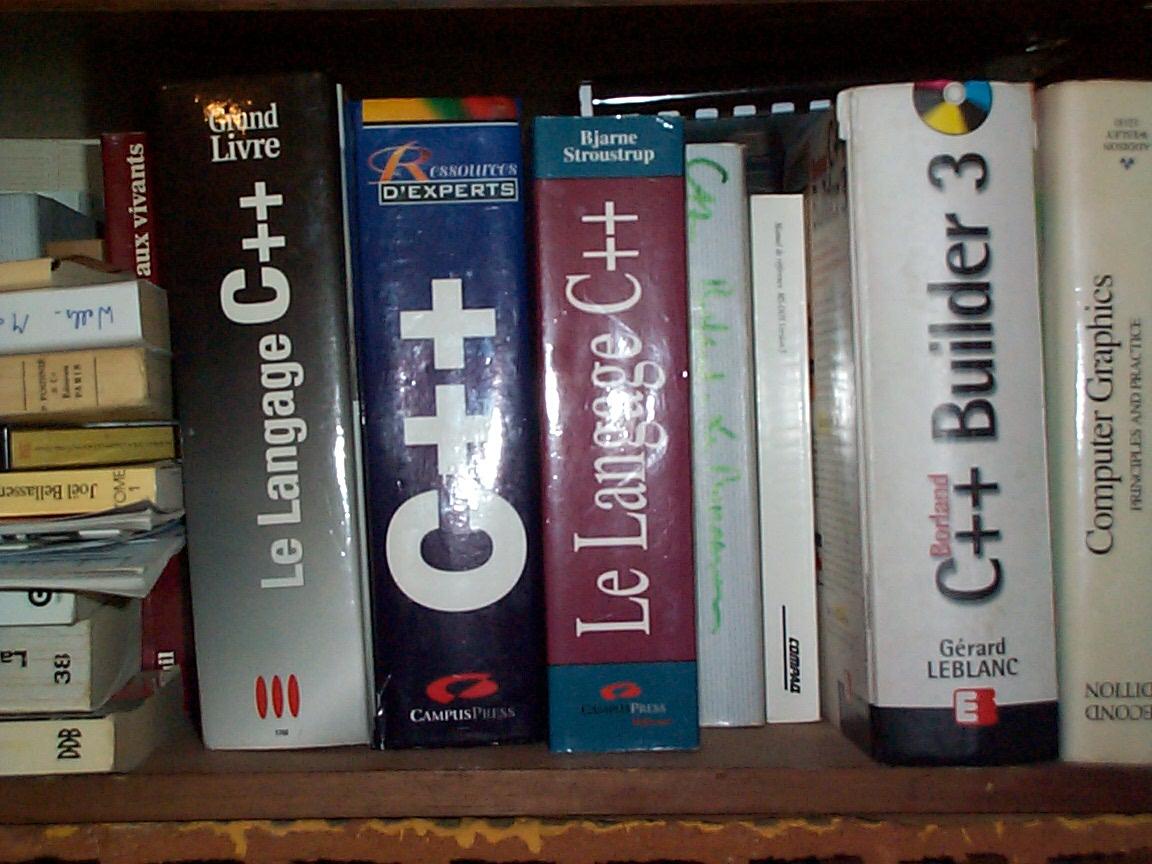 . 1993c. Programming more seriously. From C to C++.
. 1993c. Programming more seriously. From C to C++.
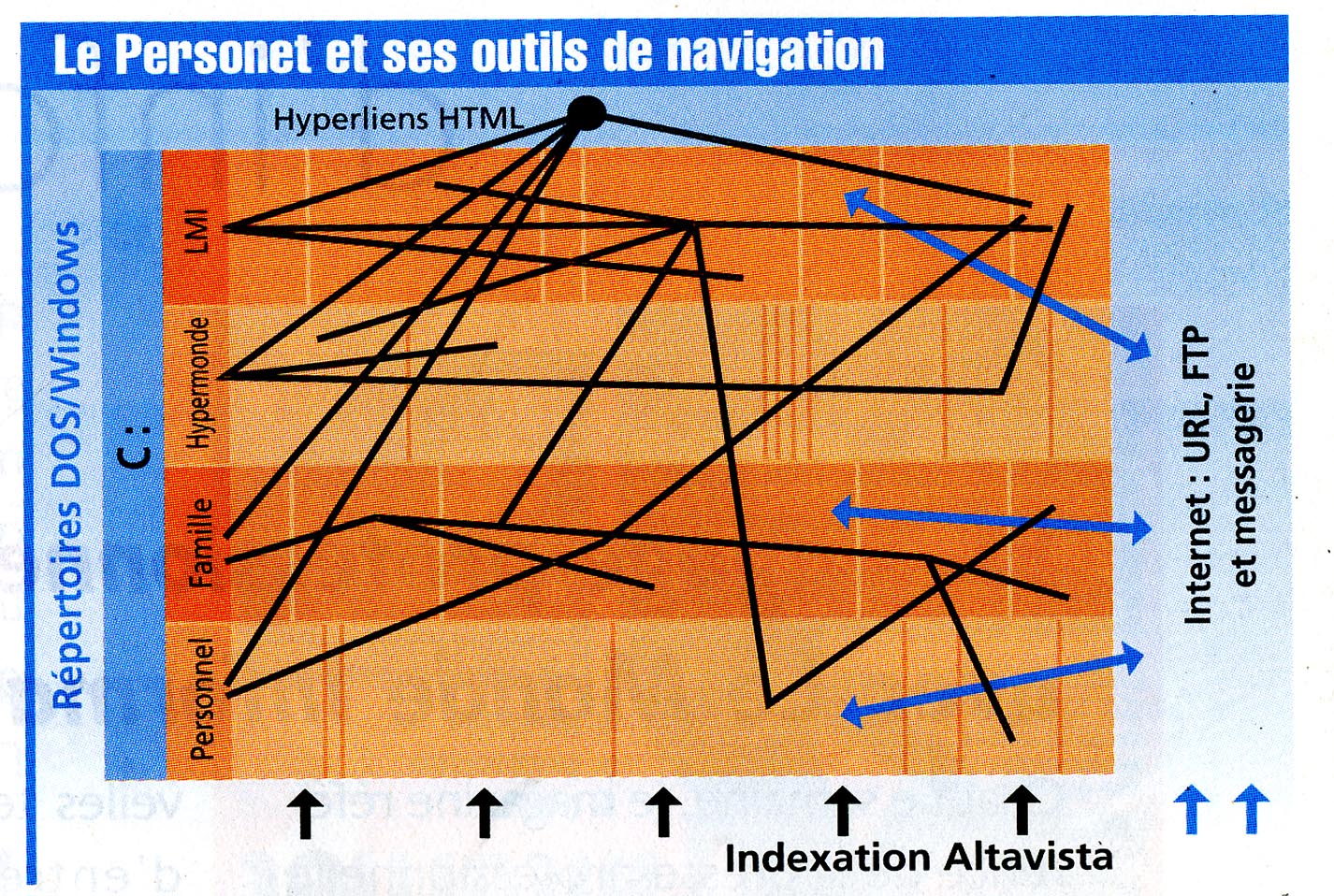 1996. After the Internet and the Intranet, I propose the "Personet". Memories become large enough, Internet brings communication. Hypertext affords integration.
1996. After the Internet and the Intranet, I propose the "Personet". Memories become large enough, Internet brings communication. Hypertext affords integration.
I see comping the problem of scanning. But they are still quite expensive. Read the paper on this topic.
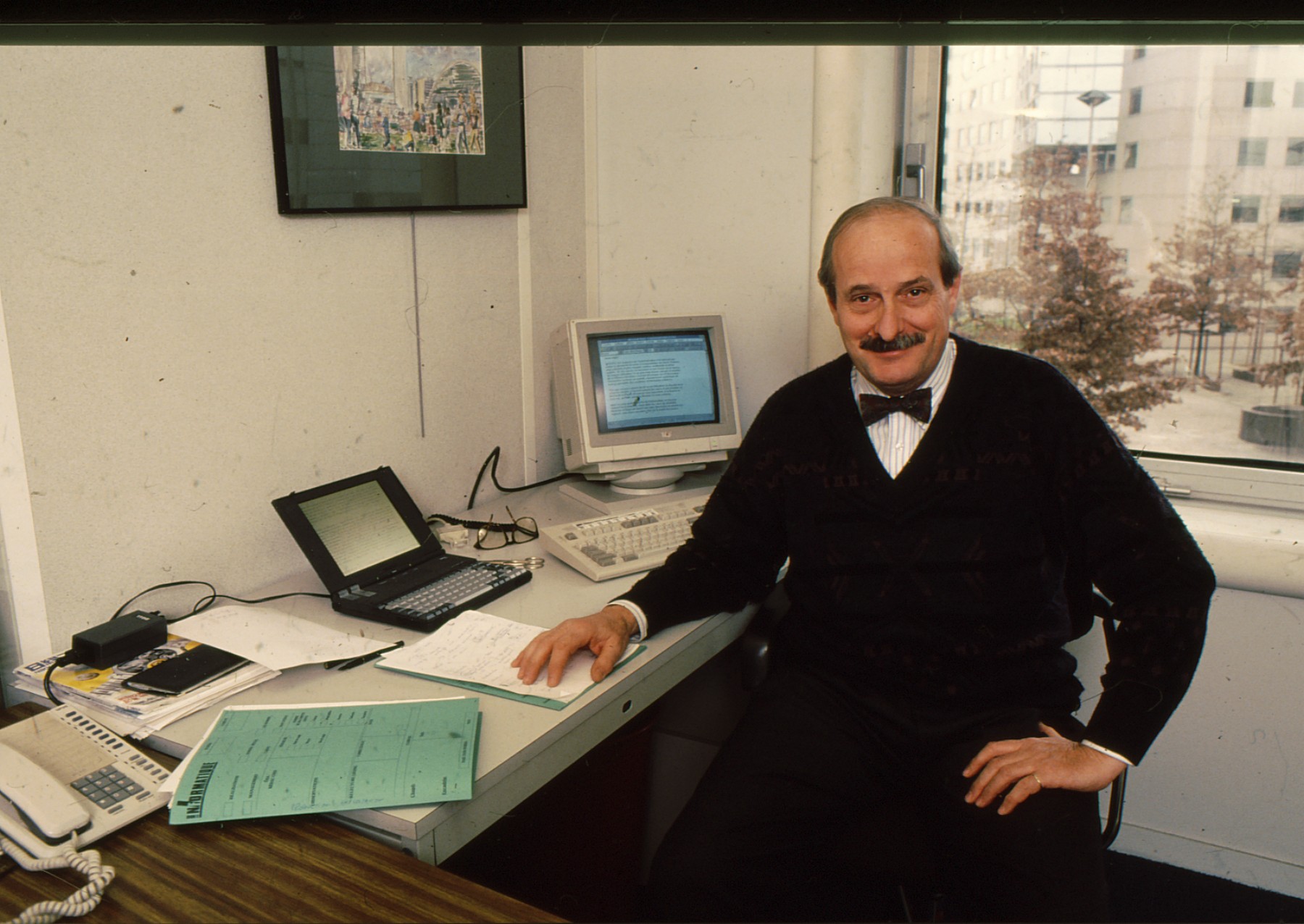 .1998c. My workplace at Le Monde Informatique. The firm desktop and my own laptop.
.1998c. My workplace at Le Monde Informatique. The firm desktop and my own laptop.
On it I begin to progam in C. Hoping even to build my own office suite. Includes a text processor and an acconuting softtware. Both very simplisitic, of couse. Called Xam. Will evolve towards artistic concepts.
I make a new series of paper and computer files about service providers.
The CD-Rom becoms the major archiving tool. It will be superseded in the late 2000's by hard disk, USB keys and the cloud.
A communication about convergence.

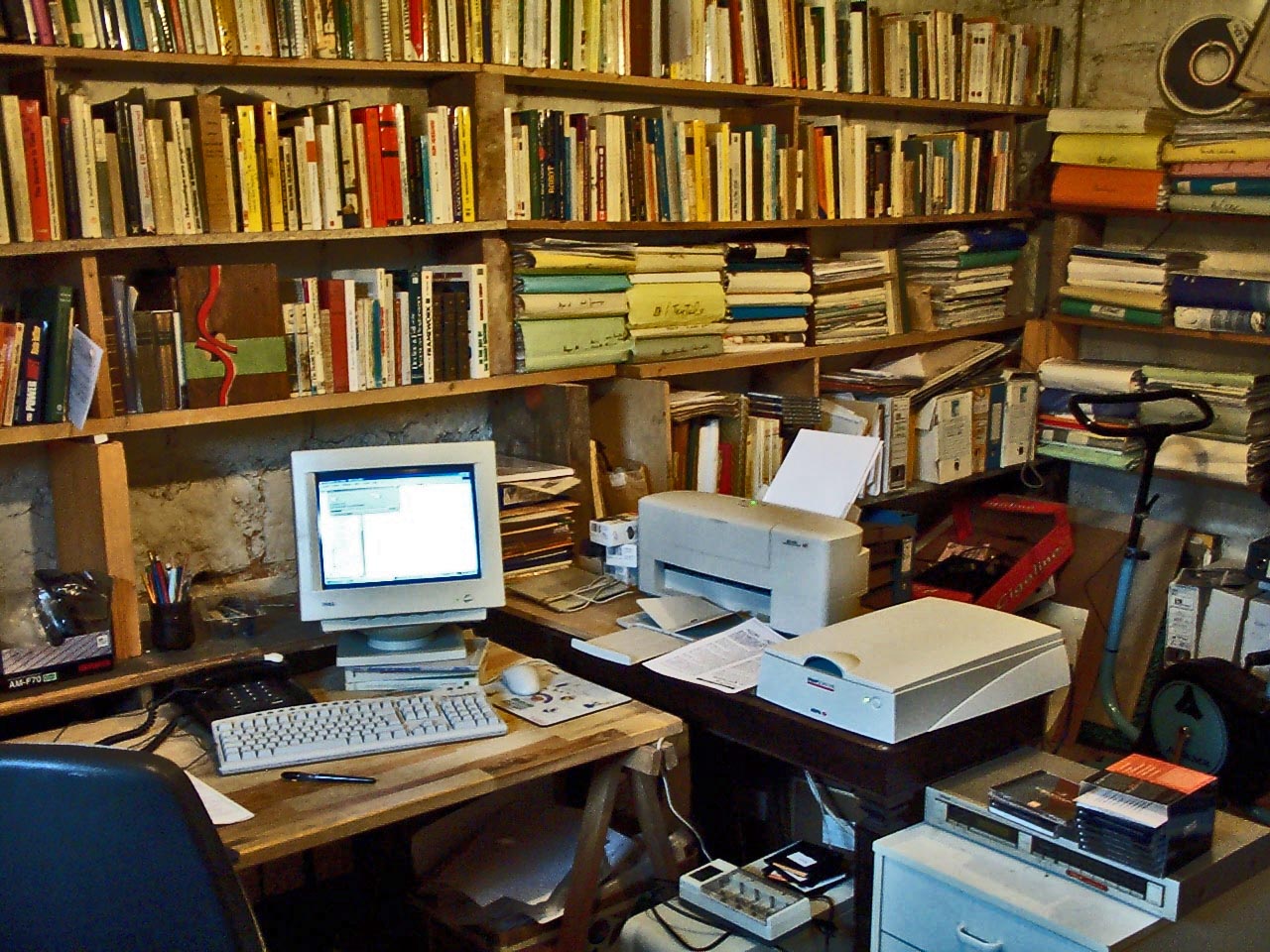 .
.
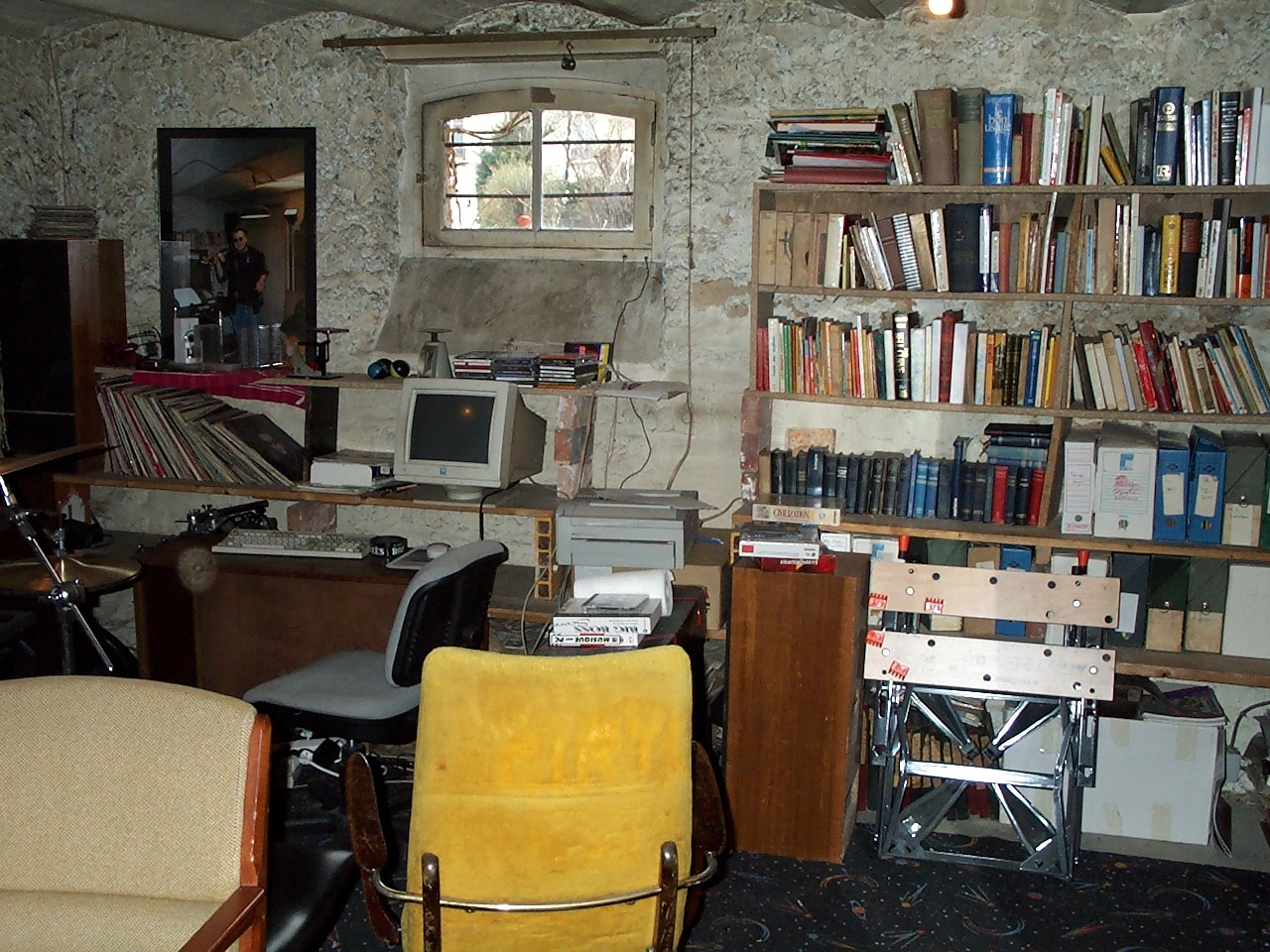 .1998. Home office
Floppy, printer, scanner, CD-Roms (?)
.1998. Home office
Floppy, printer, scanner, CD-Roms (?)
My paper files about users are now very bulky. I betgin to scan them. But too quickly. A lot of files will ve lost.
I store the data on an external hard drive. Only one copy. At a moment, the drive begins to have problems. I manage, rather acrobatically, to save everything on a new disk.
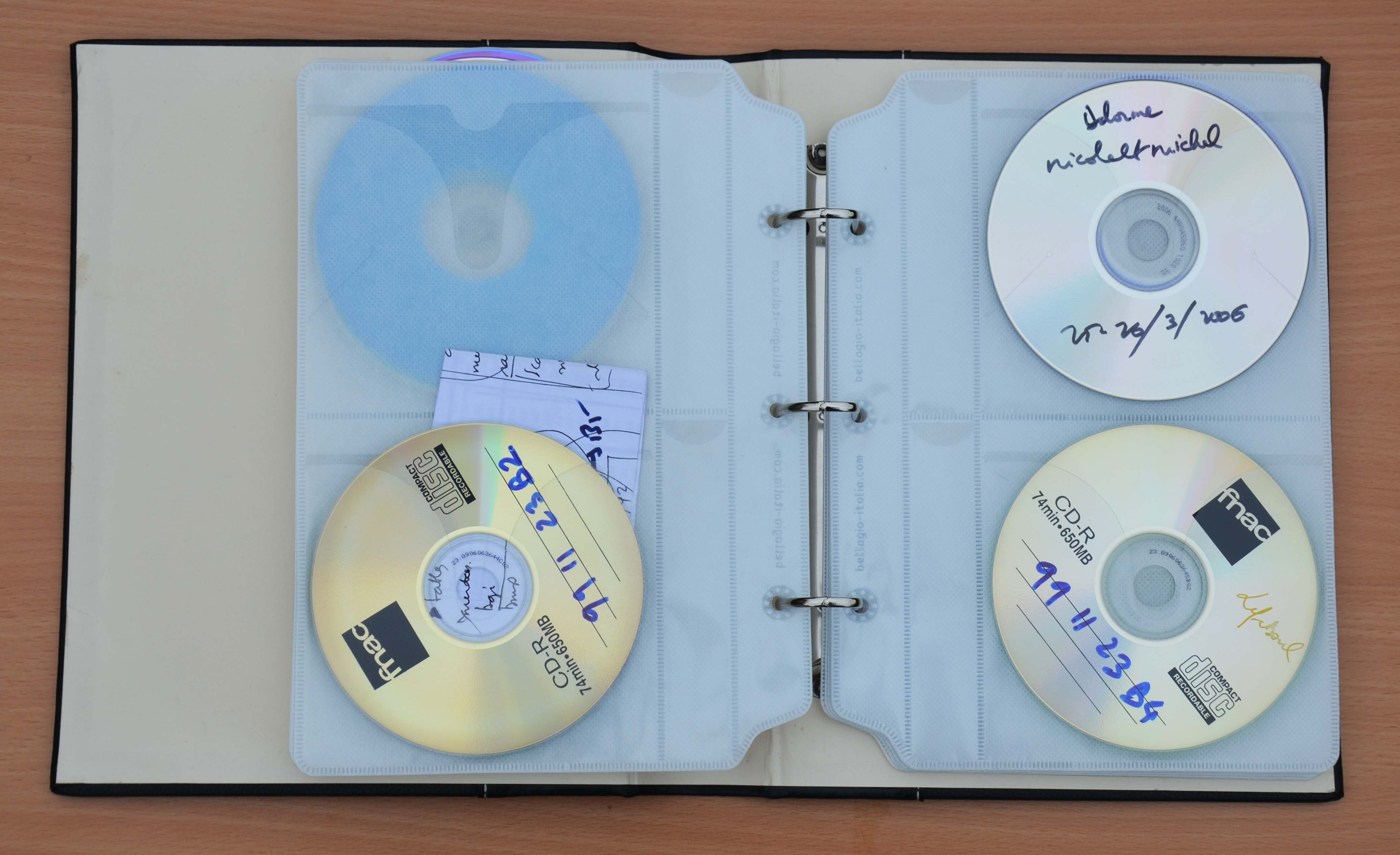 . 1999. CD-Rom burners are now cheap and lights, frerquently integrated into laptops. For the next ten years, they become my main tool for information storing and saving, including copies in different places. And also for transferring large volumes of data to other people.
. 1999. CD-Rom burners are now cheap and lights, frerquently integrated into laptops. For the next ten years, they become my main tool for information storing and saving, including copies in different places. And also for transferring large volumes of data to other people.
2001c. I prepare a CD-Rom for Lefebvre-Boulan family. With HTML text and indexes, images and some audio files, copied from audio cassettes dating from the 1960's. But nobogy in the family understands really this innovation.
Some tries with Linux. But unsuccessul. I go back to Microsoft tools.
2001. I lauch the website of Asti, and begin the Asti dicgtionary and weekly web magazine.
A first digital photo camera (offered by L&S)
I begin the development of
Roxame, as an extension of Xam (with name changed for Intellectual property reasons). In C++ then Processing. It is mainly graphic art oriented, but I wil use it for various purposes, like presentations and Diccan's index preparation.
Roxame's dictionary is a potential globalizer.
All the family films are digitized on DVD's.
General backup of all files on CD-Roms (in 2014, most of them are still readable).
Then USB Keys.
About at that time, Dreamweaver to create web pages. Progressively, I transfer all my texts in HTML for compatibility reaons, and sometimes teased by Microsoft office consraintes.
2004c.Website for Roxame
 . 2005c. Home workplace.
. 2005c. Home workplace.
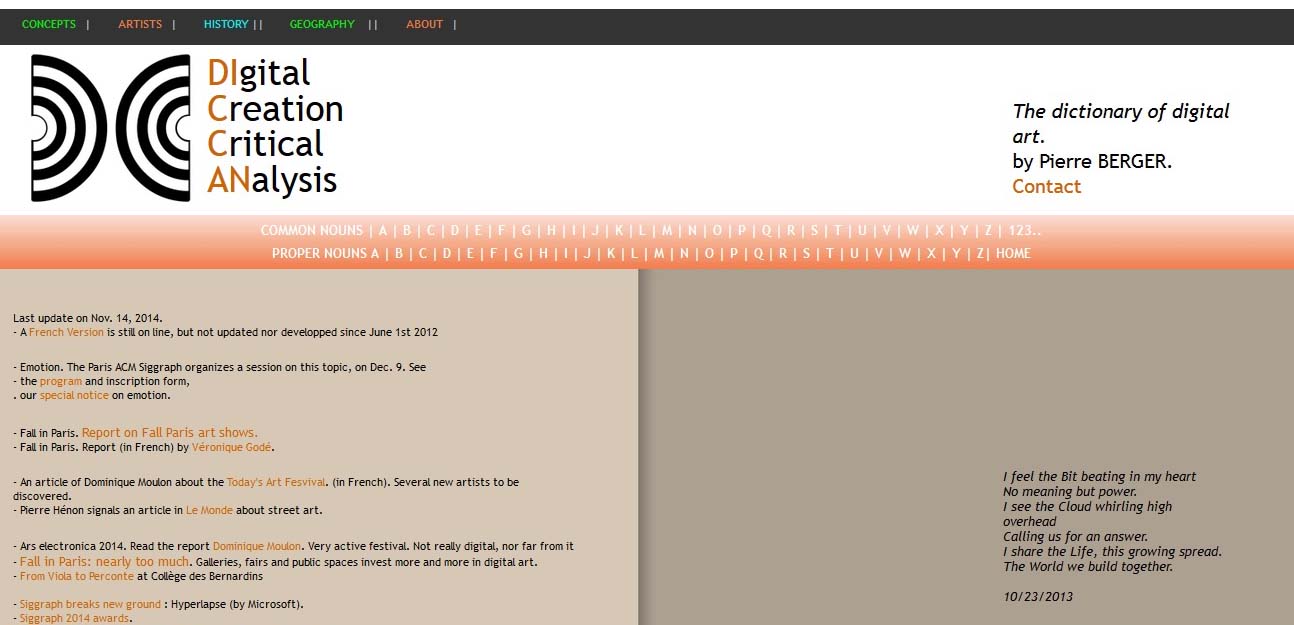 2010. Launching Diccan,. Here the 2014 home page,with the Logo and CSS designed by Anne-Claire Berger. . It includes a backup of
2010. Launching Diccan,. Here the 2014 home page,with the Logo and CSS designed by Anne-Claire Berger. . It includes a backup of
-
Club de l'Hypermonde website,
-
Roxame's website
- The Asti's dictionary
- Asti weekly
and the major contets of Asti website, and the public part of my today's personal information system. See for instance
- index by business sectors (and publishing dates)
- general articles on information systems.
 .2011. Home workplace
.2011. Home workplace
More than ever teased by Microsoft constraints. And afraid of Google indiscretion...
2014. Scanning of photo family albums.
Starting to make videos.
At the end of 2014,the global content files 90 Gbytes
Years to come.
Completion of integration.
There are still a lot of paper documents. The project is to limit them exclusively to
- beautiful documents having a value by themselves,
- exemplary documents to show how documents were materially in the time of theircreation.
Everything on the cloud ?
Better use of social networks and mobile tools.
 1940's. My father and elder brother were, of had been, Meccano fans.Si did I. It has a philosophical facet: you can build the whole world from a set of standard parts. Coupling that with the universlit Christian motto "gather toghether in one all things in Christ" sew early in my mind a global minframe of total reconstruction. In 2014, that can be transposed to bits for Meccano parts, and to the cloud for Christ (with my apologies to believers).
1940's. My father and elder brother were, of had been, Meccano fans.Si did I. It has a philosophical facet: you can build the whole world from a set of standard parts. Coupling that with the universlit Christian motto "gather toghether in one all things in Christ" sew early in my mind a global minframe of total reconstruction. In 2014, that can be transposed to bits for Meccano parts, and to the cloud for Christ (with my apologies to believers).
 . 1982. My first computer with all possible applications... but only 16Kb of central memory and 1Mb of data on a double 8" floppy disk readar This same year, I had my first email exchanges on Internet through the minitel. Main applications: text writing, editorial cooperation. Some administrative tasks. Some games also on a smaller computer.
. 1982. My first computer with all possible applications... but only 16Kb of central memory and 1Mb of data on a double 8" floppy disk readar This same year, I had my first email exchanges on Internet through the minitel. Main applications: text writing, editorial cooperation. Some administrative tasks. Some games also on a smaller computer.



 .
. 

 . 1960. Roneo. On this kind of machine I printed my first long text (150 copies). I had to prepare a stencil (s sort of serigraphic document) for each page, with a typewriter for text and a vibrating stylus for images.
Binding led me to discover latex glues, which I used for binding the copies, and later extended to all my paper document sets.
. 1960. Roneo. On this kind of machine I printed my first long text (150 copies). I had to prepare a stencil (s sort of serigraphic document) for each page, with a typewriter for text and a vibrating stylus for images.
Binding led me to discover latex glues, which I used for binding the copies, and later extended to all my paper document sets.






 1972. For family uses, I buy a Volkswagen Combi. It dream of fitting a library, computing and communications facilities in it. Everything everywhre the wind pushes. It will become a practical reality with the laptops, some 20 years later.
1972. For family uses, I buy a Volkswagen Combi. It dream of fitting a library, computing and communications facilities in it. Everything everywhre the wind pushes. It will become a practical reality with the laptops, some 20 years later.



















 . 1989. PC desktop with floppies and telephone. At LMI Avenue de Neuilly
. 1989. PC desktop with floppies and telephone. At LMI Avenue de Neuilly 
 Software : Framework. The first integrated office tool. It will a little later superseded by Microsoft Office.But fortunately, during several monthes, conversion tools were available and I could save my text files of this period.
Software : Framework. The first integrated office tool. It will a little later superseded by Microsoft Office.But fortunately, during several monthes, conversion tools were available and I could save my text files of this period. 










 . 1999. CD-Rom burners are now cheap and lights, frerquently integrated into laptops. For the next ten years, they become my main tool for information storing and saving, including copies in different places. And also for transferring large volumes of data to other people.
. 1999. CD-Rom burners are now cheap and lights, frerquently integrated into laptops. For the next ten years, they become my main tool for information storing and saving, including copies in different places. And also for transferring large volumes of data to other people.

 2010. Launching Diccan,. Here the 2014 home page,with the Logo and CSS designed by Anne-Claire Berger. . It includes a backup of
2010. Launching Diccan,. Here the 2014 home page,with the Logo and CSS designed by Anne-Claire Berger. . It includes a backup of 